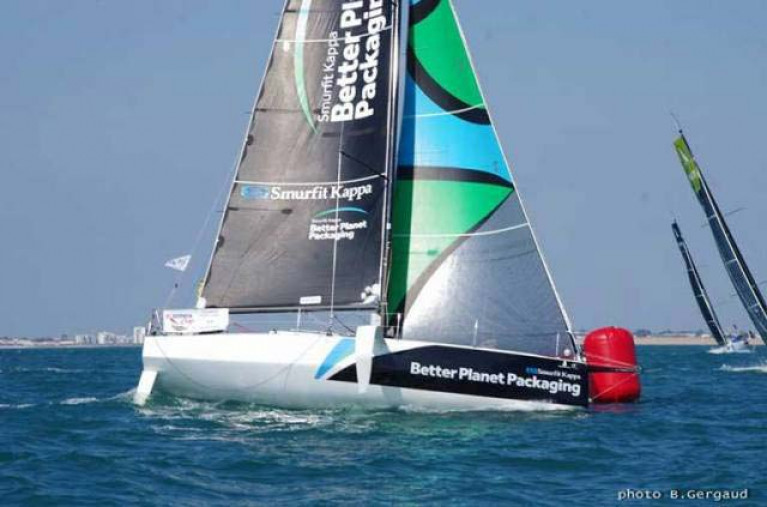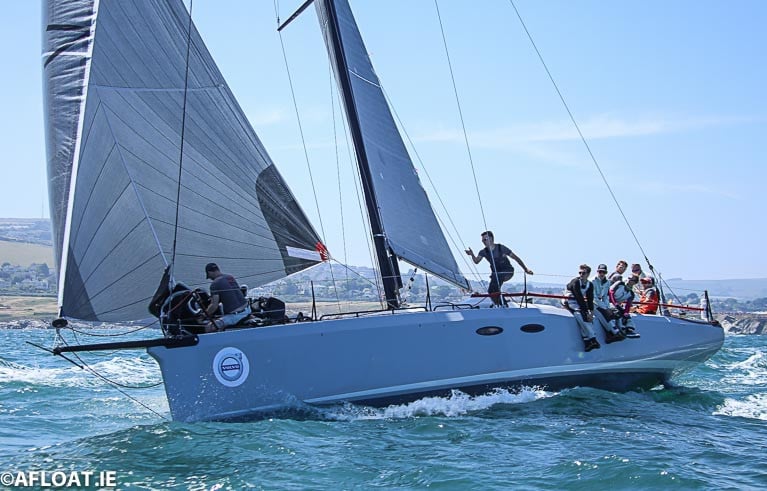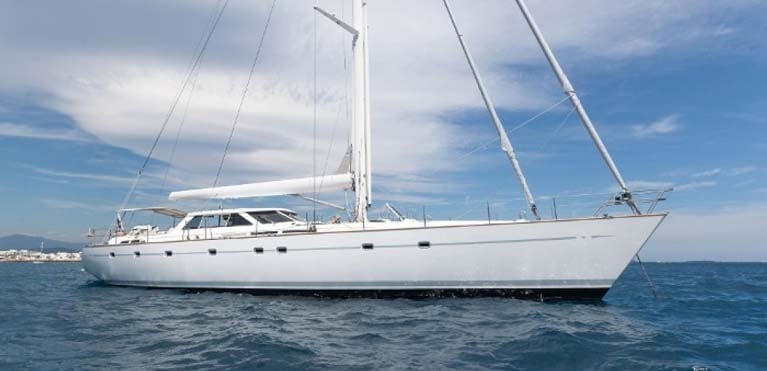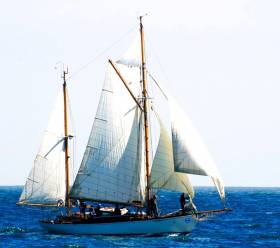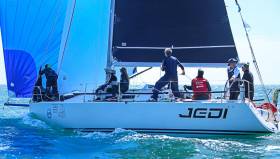Displaying items by tag: Round Ireland
Sailing Round Ireland Dream Realised on Jeanneau Sun Odyssey 349
As a citizen of an island nation, John Latham long had the desire to sail around this country, headland by headland. With that in mind, co-owner John McQuaid and he were determined to carry out such a voyage in their Jeanneau Sun Odyssey 349, Scoundrel, from their home port Dun Laoghaire on Dublin Bay.
Scoundrel was purchased early in 2017 and we had a good shakedown cruise to West Cork during that first summer…Baltimore, Schull, Crookhaven, Cape Clear and around the Fastnet. She proved a comfortable and seaworthy yacht excelling on a beat back to Baltimore from Fastnet in a force 6 gusting 7 … twin rudders and hard chine give her a stiffness and control which surpasses our expectation.
The cruise of 2018 beckoned with the lure of more Westerly and Northerly ambitions.
We decided to have 2 parts to this voyage and conduct a clockwise circumnavigation:
- A non-stop passage of about 250NM from Dun Laoghaire to Dingle in Co. Kerry on the S.W. Coast during the last weekend of June.
- Join the boat again in Dingle on 15th July and continue our venture in daily passages up the Atlantic coast and around the North of Ireland and back into the North Channel and the Irish sea to home. We had 2 weeks for this part, each owner requiring to be back at work on the 30th July. A rather tight schedule you might agree.
All of this would be dependant on the weather and the performance of boat and crew as well as the occurrence of the unexpected in the way of natural or man-made emergencies, misadventures or calamities. But that uncertainty and anxiety are partly why we go cruising!
For most of the circumnavigation, we would be a crew of 3 …the 2 owners and John McQuaid’s son Eoin. Time on his hands and a certain sense of adventure attracted Eoin to this escapade but we knew that at some stage along the West Coast he planned to jump ship for social and romantic reasons. We were confident that 2 would then handle Scoundrel comfortably.
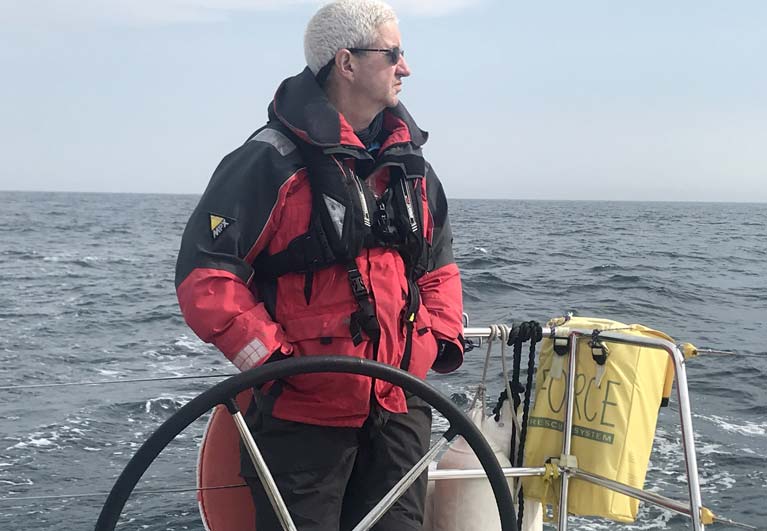 John McQuaid
John McQuaid
28 June. We were still in that prolonged period of high pressure and little wind. This first passage included the leg south from Dublin Bay to Carnsore Point inside the banks and the Tuskar Rock. Then followed the long trek westwards along the South Coast, passing at a distance off our usual West Cork cruising grounds and nudging north into the Atlantic coast to Dingle in Co. Kerry. The only wind of note was a northerly force 4, on our nose as we crossed Dingle Bay from Valencia Island.
This long, windless, non-stop passage from Dun Laoghaire to Dingle was 275 NM and we were underway for almost exactly 48 hours. All of this was under engine at 2,500 revs at an average speed of 5.7 knots. Diesel and factor 50 sunblock was at a premium!
The only crisis of this passage was the tangling of the propeller with a lobster pot line close to the Conningbeg light off the Saltee Islands. Instantly volunteering, Eoin donned a wetsuit, dived below the boat and with a diver’s knife freed us from this unwelcome tether.
The famous and aged dolphin Funghi welcomed us in the channel at Dingle harbour where the excellent Marina and extremely helpful staff supplied a safe berth for 2 weeks as well as green diesel in cans.
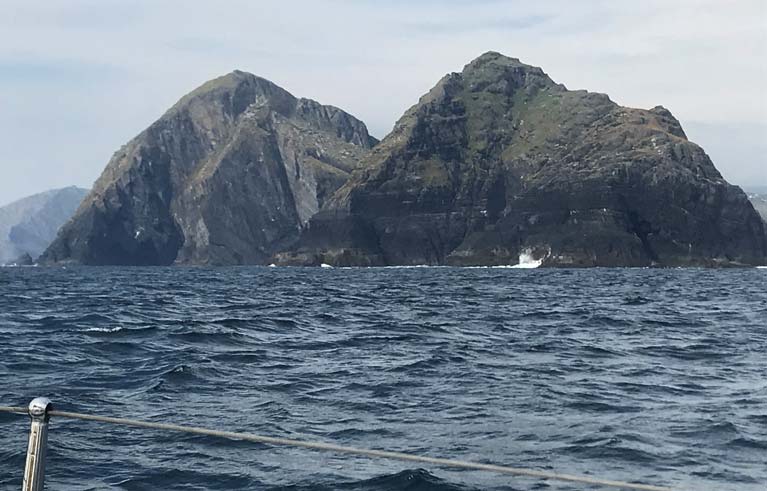 Valentia Island
Valentia Island
Sunday 15 July. We continued our cruise and left Dingle at 07.20 towards Fenit in Tralee Bay. We experienced a S.W. breeze force 3 to 4 and sailed for 6 ½ hours, motor-sailing for 2 ½. The log showed 50.7 NM in 9 hours. A highlight of this passage was passing through the Blasket Sound. Newly restored houses on the Great Blasket Island gleamed white as we kept well off Slea Head and its rocky dangers. Crossing Brandon Bay we encountered a very playful pod of at least 10 dolphins who accompanied us for several miles. It was decided to pass outside the Maharee Islands as rain and poor visibility had set in. Fenit, on the northern side of Tralee bay, was gained after a brisk reach to Great Samphire Island to which the excellent marina is attached.
 Great Samphire Island
Great Samphire Island
 The County Kerry coast
The County Kerry coast
Monday 16th. Our 35-mile passage was towards Kilrush in the Shannon Estuary. We beat out of Tralee Bay and then maintaining a broad reach up to the Estuary we ran eastwards towards Scattery Island which lies off Kilrush on the Northern shore. The famous pod of Shannon Dolphins accompanied us for 4 or 5 miles. Kilrush Marina, in County Clare, is approached through a lock which maintains depth at all tides. More like inland waterway than sea marina this was a very comfortable berth.
Tuesday 17th. A lovely 60-mile passage towards Kilronan on Inishmore, the largest of the Aran Islands. But first we had a slog under engine out of the Shannon Estuary to Loop Head. This was followed by a favourable westerly force 3 and 4 bringing us past the coast of County Clare and the dramatic Cliffs of Moher. Kilronan on the N.E. of Inishmore is approached from the south via Gregory Sound with Inishmaan to starboard. On our approach to the Sound, a very large swordfish jumped high out of the water with a bright flash of silver. A visitors mooring at Kilronan proved very comfortable with a dinghy trip of about half a cable to a sandy beach and slip.
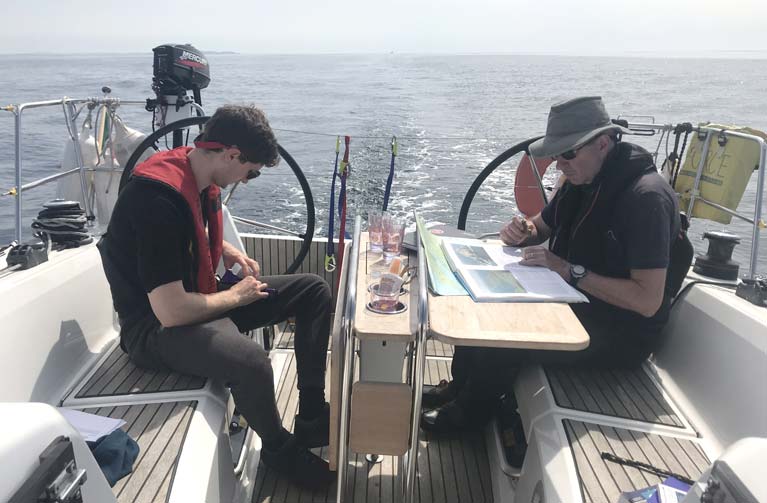 Passage planning time
Passage planning time
Wednesday 18th. A day on the Island. The only place where we spent a full day exploring; Inishmore provided us with a sunny day of walking and visiting Dun Aengus the Bronze Age promontory fort. We enjoyed the hospitality of the islanders. A swim in the harbour off the back of the boat proved very refreshing.
Thursday 19th. Commencing at 06.30 this was a passage from Inishmore to Clare Island, 62 miles in 12 hours. The highlight for me was the remarkable view of the Maamturk Mountains of North Connemara which were in view to the East, shimmering smoke grey peaks and ridges …tempting lures for future mountaineering expeditions. The Atlantic coast cannot be surpassed for dramatic scenery, high cliffs, mountains and mighty headlands. Islands are a special feature of this most western part of Europe and we were sorry that we had only time to visit three. This passage took us south of the extensive maze of rocks which guard South Connemara and Roundstone, then around Slyne Head, inside High Island and then a course of 060 M brought us inside Inishbofin and Inishturk islands. Our arrival at Clare Island Harbour at 18.30 coincided with mist and drizzle as we took a visitors mooring overlooked by Gráinne Ní Mháille’s Castle. Also known as Grace O’Malley, she was the famous 16th century “pirate queen”. We enjoyed a splendid fish dinner and Guinness at the Sailor’s Inn.
Friday 20th. The postmaster Páiric O’Malley sold us some provisions and lent us the key to the remarkable 14th-century abbey with residual painted frescoes still extant. Eoin took the ferry to Roonah Quay on the mainland and the two Johns continued the venture. Leaving our mooring at 11.08, a 50-mile passage towards Broad Haven, an anchorage on the southern shore of Donegal Bay was our aim. Being a dull day with drizzle and fog and light westerly breeze we motored, firstly N.W. to make Achill Head and then west of the Inishkea Islands and many other rocky protuberances guarding the Mullet Peninsula. During this rather tedious passage, we passed only 2 other vessels, a trawler fishing and a yacht heading South, neither of which were transmitting AIS. On the West Coast, we rarely met other yachts; fishing vessels showing AIS were in a minority! At 20.20 we entered the narrow inlet on the South of Broad Haven Bay and anchored N of the fishing pier at Ballyglass. A very comfortable night with only one Scottish yacht nearby.
Saturday 21st. We weighed at 06.20 to commence a 54-mile passage across the mouth of Donegal Bay towards Teelin Harbour on its Northern Shore. There were no hazards or navigational challenges during this passage…which concluded in a very thick fog and a dead run in a force 3 to 4 SW breeze. Teelin Harbour on the N.W. of Donegal Bay is hidden within steep surrounding cliffs at the best of times but with visibility down to 100yds, the small lighthouse at the entrance was a welcome sight as we rounded up and took a temporary berth at a fishing boat pontoon. Paddy Byrne, a local boatman kindly lent us his hose for filling our water tank. A visitors mooring provided a very comfortable night and a pub called the Rusty Mackerel provided an excellent dinner.
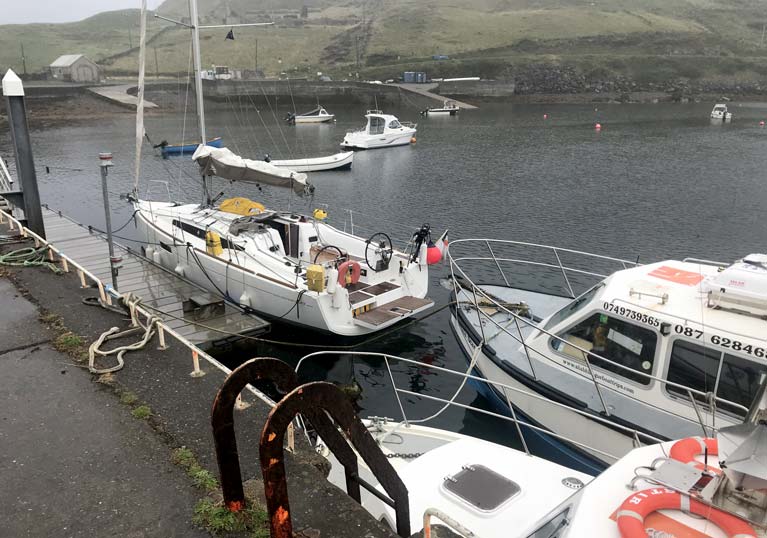 Scoundrel snug on a visitor mooring in Teelin Harbour on the N.W. of Donegal Bay
Scoundrel snug on a visitor mooring in Teelin Harbour on the N.W. of Donegal Bay
Sunday 22nd July. This passage from Teelin towards Tory Island, 55 miles was delayed until 10.30 when the thick fog lifted slightly giving us some visibility of the bulk of Donegal to the north as we motor-sailed out beyond Rathlin O’Beirne Island and headed NNE towards Aran Island. Most of the passage was a dead run in a force 4 under main alone. ..not having a spinnaker or a pole for goose-winging the jib … the wind was too far aft for our asymmetrical chute. This fairly uneventful passage became more dramatic as we approached Tory Harbour from the south with the wind piping up to 25 Kts. Choppy seas were manageable but on approaching the high harbour pier, fenders to the ready on the starboard side, sidling at dusk into a nice berth next to a ladder, our cruise nearly ended in disaster! Scoundrel came to an abrupt and sickening, clanging halt as a hydraulic crane jib, protruding 90 degrees out from the pier engaged with our mast about two-thirds up. My heart sank as I imagined the rig coming down around our ears. A gust blew off the pier and we disengaged from this aerial hazard. Mast and rigging survived unscathed, not so our nerves! This most remote of the Irish Islands deserves a prolonged visit but we needed to press on. Gales were being forecast in the Irish Sea from mid-week onwards.
Monday 23 July. This passage towards Portrush in Co. Antrim began at 07.00 in drizzle and turned out to be a lovely 85 miles 13-hour sail across the top of Ireland. Initially an easterly (078deg M) fetch to Malin Head and then S.E. towards Portrush. However some miles off our destination, on radioing Portrush Harbour Master we were informed that we could not enter as a stone barge was blocking the harbour. The evening was fair and, undismayed we altered course for Ballycastle some 15 miles further East. At 20.15 we entered this beautiful marina to a splendid welcome from staff and local boat owners; we no longer felt rejected. On the South of Rathlin Sound (famous for that dramatic tide race), Ballycastle is a lovely town with very clear views of the Mull of Kintyre.
Tuesday 24 July. A 45-mile passage from Ballycastle to Bangor in Belfast Lough. With a flat calm but a favourable tide, we shot out of Rathlin Sound into the North Channel with the beautiful hills of Antrim as our backdrop on the starboard side and Scotland to Port. A lovely, sunny evening landfall at Bangor’s Large and delightful Marina completed our penultimate passage. Celebrating with spaghetti Bolognese and accepting freshly picked tomatoes from my Belfast brother in law Eddie, John and I turned in early.
Wednesday 25 July. Starting at 04.25 This southerly homeward passage was 102 miles mostly under engine with a light southerly breeze. Highlights were views of the beautiful Mountains of Mourne in Northern Ireland and the Cooley Mountains on the southern side of Carlingford Lough. In good visibility, the Isle of Man was clearly in sight for much of this passage. On arriving north of Howth Head which guards Dublin Bay, we were hard on the wind with a foul flood tide impeding progress. Here I made a tactical error and took a tack to leeward of Lambay Island. This left us with a hard 2-hour slog against wind and tide to round Howth Head and the final fetch across the bay to Dun Laoghaire. We were on our marina berth at 22.10 having passed lines to our adoring wives.
Time underway: 158 hours … 124 motor-sailing, 34 under sail alone.
Total Distance Logged: 858 NM
Average speed: 5.4 kts
Diesel consumption: 250 L at approx 2,500 revs. Consumption approximately 2L per Hour
John Latham, 25 September 2018
Ross O'Leary of MGM Boats adds: The Jeanneau Sun Odyssey 349 is currently the most successful and best-selling production sailing cruiser in Ireland. Perfect size for our shores - it offers great comfort, space and stability. Modern chined hull design with twin rudders give unrivalled seakeeping performance that suits all levels of sailing experience.
Irish Offshore Selection Trial to be Part of Round Ireland Race
Irish Sailing has been forced to shelve this month's planned trial for Irish entry into the 2020 Offshore World Championships and will look at running the trial as part of the Round Ireland Race instead.
As regular Afloat readers will know, the 2020 Offshore World Championships is taking place in Valletta, Malta as part of the Rolex Middle Sea Race from 10-22 October 2020. Ireland has already secured an entry into the Mixed Two Person Event – one male and one female, which is a new event for the 2024 Olympic Games in Paris.
There had been some early declarations for the event.
Irish Sailing had planned to run a selection trial scheduled between 28 March and 5 April 2020 and centred around the Solo Guy Cotton Concarneau regatta in France.
Due to restrictions around Covid-19 these trials have been forced to be rescheduled. Irish Sailing says it is now looking at options to run the selection trials in cooperation with the organisers of the Round Ireland Yacht Race due to start 20th June.
Further details around choice of boat and NOR will be published shortly.
Round Ireland Yacht Race Record Entry in Prospect?
Coronavirus may have postponed tonight's official launch party but there's no stopping interest in June's SSE Renewables Round Ireland offshore race that gets underway in 14 weeks time.
The prospect of some potent international entries into this year's race is adding extra spice to an already a bullish entry for the 21st edition.
The 2020 race from Wicklow Sailing Club is already being billed as a potential 'record' one by organisers and that's quite an achievement given the year's packed offshore fixture list.
The much-rumoured entry of the French offshore great Teasing Machine plus the entry of a JPK 10.30, according to an Afloat source. has the potential to make this a very special international race indeed.
Launched in July 2017 with success in the 2017 Rolex Middle Sea Race, as its class winner and third overall, Owner Eric de Turckheim's Teasing Machine is a well blooded offshore racer having also competed in the Sydney-Hobart race.
 A new JPK 10.30 design could be on the cards for June's Round Ireland Race Photo: Carlo Borlenghi/Rolex
A new JPK 10.30 design could be on the cards for June's Round Ireland Race Photo: Carlo Borlenghi/Rolex
The solid take-up defies early fears that the race might have struggled with other key fixtures such as early July's Kingstown to Queenstown Race and the Morgan Cup from Cowes to Cork Week.
Entries received to date include Malta, UK, USA, Scotland, Wales, Isle of Man, France, Germany and Ireland while the race is a starred event in the Royal Ocean Racing Club's calendar meaning more overseas entries are likely. The largest entry is the 21m Neptune 3 from Malta skippered by Greg Miller. She will be joined on the start line by former Round the World boat 70-footer Telefonica Black under Lance Shepard from the UK.
Round Ireland is the second longest race in the Royal Ocean Racing Club calendar and first race took place in 1980 with only thirteen boats. Since then, held biennially, the fleet has grown steadily, attracting a record 64 entrants for its biggest ever edition in 2016 which four years later may yet be eclipsed.
There are a number of classes in IRC in which boats and their crews can compete, including IRC 1 – 4, Z class, ISORA, a ‘Two-handed Class’ and a Team Prize. The 2016 race saw the introduction of multihulls sailing under MOCRA rules. The 2018 race saw the introduction of a new Class 40 category. In the past, boats competing have ranged from a 98-footer former “round the world” maxi, to club boats one third the size, with all shades in between.
Some of the latest entries are Cork Harbour boats with double winner Cavatina and the Grand Soleil Nieulargo both signed up in the past fortnight. Last weekend, the new Sun Fast 3300 was launched at the Royal Irish Yacht Club and this new marque from Jeanneau will race the circuit under the burgee of Kinsale Yacht Club.
W M Nixon will preview all the latest Round Ireland entry news in his weekly blog on Afloat this Saturday here.
Round Ireland Yacht Race Entries Already Going Big On Size & Variety
It may be only mid-February, but entries for the 704-mile 40th Anniversary 21st edition SSE Renewables Round Ireland Yacht Race from Wicklow on June 20th are already on the two dozen mark, and the fleet is remarkable for its variety of size and type, writes WM Nixon.
In an initial lineup which has 15 boats from outside Ireland, the most exotic has to be Neptune 3 from Malta, the 26-metre alloy Fitzroy cutter (with Judel Vrolik input) which is skippered by Greg Miller.
Another biggie is the former Volvo 70, Telefonica Black, while smallest is the First 310 More Mischief, just 9.15 metres long and entered by Grzegorz Kalinecki of Dun Laoghaire. At the moment there’s only one J/109, Outrajeous from Howth entered by Johnny Murphy, who co-owns her with ICRA Commodore Richard Colwell, but doubtless others of this famous marque will throw their hat into the ring in due course.
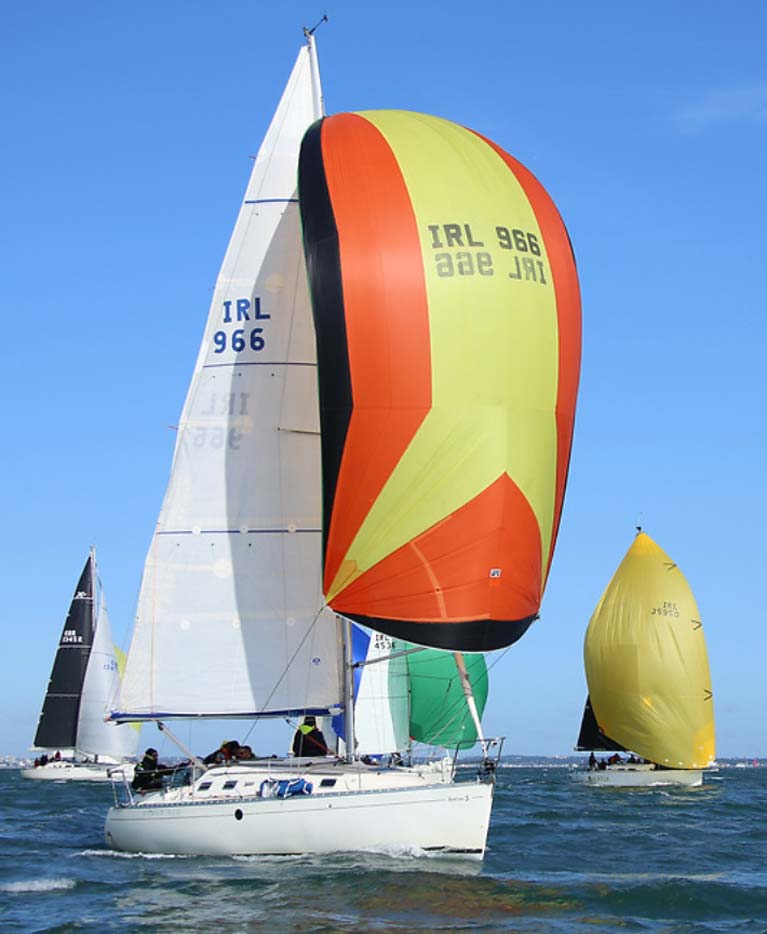 The First 310 More Mischief from Dun Laoghaire is currently the smallest entrant. Photo: Afloat.ie/David O’Brien
The First 310 More Mischief from Dun Laoghaire is currently the smallest entrant. Photo: Afloat.ie/David O’Brien
Paul O’Higgins’ otherwise all-conquering JPK 10.80 Rockabill VI (RIYC) is down to go for her third campaign in a circuit where victory has eluded her so persistently - despite conspicuous successes in every other offshore competition - that it’s all beginning to be reminiscent of Saoirse Ronan and the Oscars……
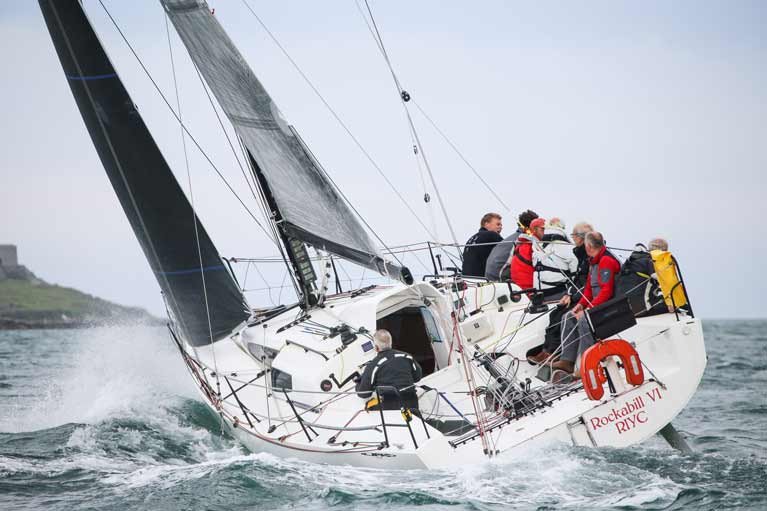 The Saoirse Ronan of Irish offshore racing? Paul O’Higgins’ otherwise all-conquering JPK 10.80 Rockabill VI (twice winner of the Dun Laoghaire-Dingle Race) is entered for her third Round Ireland challenge, despite success eluding her in 2018 and 2016 when she seemed to win everything else on the offshore circuit. Photo: Afloat.ie/David O’Brien
The Saoirse Ronan of Irish offshore racing? Paul O’Higgins’ otherwise all-conquering JPK 10.80 Rockabill VI (twice winner of the Dun Laoghaire-Dingle Race) is entered for her third Round Ireland challenge, despite success eluding her in 2018 and 2016 when she seemed to win everything else on the offshore circuit. Photo: Afloat.ie/David O’Brien
International Interest as Wicklow’s Round Ireland Race Comes of Age
This year, with the fresh sponsorship of SSE Renewables, the Round Ireland Race from Wicklow comes of age. The 21st staging of the biennial classic – now an international event, included in the Royal Ocean Racing Club’s programme and an integral part of its annual points championship – will mark four decades of exceptional enthusiasm and voluntary dedication by a relatively small sailing club in a little river mouth port, a harbour town which successfully asserts its special position and unique identity in an Irish sailing scene which otherwise tends to be dominated by four or five much larger sailing centres.
Although the entry process for 2020’s race on June 20th was only opened as recently as January 20th, confirmed entries are already pushing towards the 20 mark, and while the latest entry is the Xp44 WOW (George Sisk) from the Royal Irish YC in Dun Laoghaire, a notable feature of the early entries is their overseas range, including Hiroshi Nakajima’s classic Sparkman & Stephens 49 Hiro Maru, from the US, campaigning in Europe after last year’s Transatlantic Race.
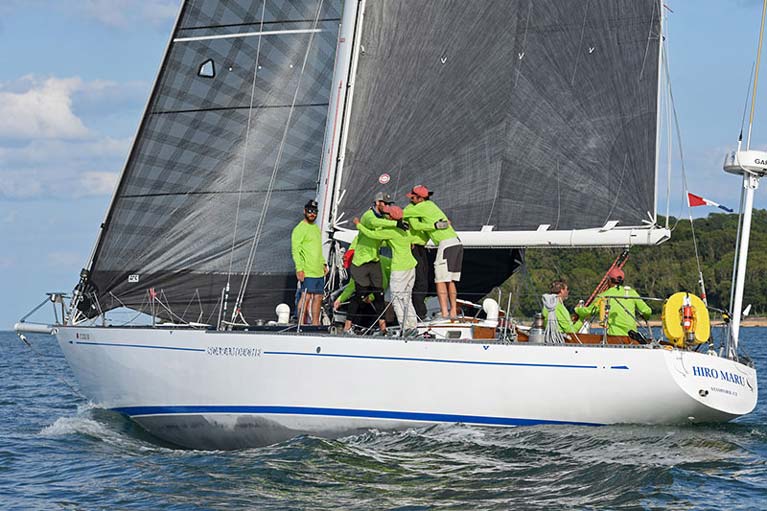 An American entry already in for the SSE Renewables Round Ireland Race 2020 is Hiroshi Nakajima’s 1971-vintage S&S 49 classic Hiro Maru, built-in aluminium by Palmer Johnson of Sturgeon Bay, Wisconsin, the builders of Ted Turner’s 1979 Fastnet Race winner Tenacious
An American entry already in for the SSE Renewables Round Ireland Race 2020 is Hiroshi Nakajima’s 1971-vintage S&S 49 classic Hiro Maru, built-in aluminium by Palmer Johnson of Sturgeon Bay, Wisconsin, the builders of Ted Turner’s 1979 Fastnet Race winner Tenacious
This international interest has been a central theme of the Round Ireland Race from its early days, and in some years such as 2016 when George David’s mighty mono-hull Rambler 88 and three MOD 70 trimarans established a complete raft of new records, it has been the dominant feature. But equally, for many offshore racers from clubs all round Ireland and further afield, racing round Ireland is a rite of passage, so special for some that they do it many times.
But at whatever level you participate, in whatever size of boat, there is something profound, something unique and deeply satisfying, about racing round our island home, experiencing its incredibly varied weather, its majestic coastline, its wayward tides, and the camaraderie which develops among competitors, whether as shipmates or friendly rivals. And with this 21st staging of the race, it is time to put the story in context.
Forty years ago on Saturday 28th June 1980, a varied fleet of 13 small to medium-sized cruiser-racers came to the starting line off Wicklow, and headed south with the gathering ebb tide and a summery easterly breeze in the first non-stop Round Ireland Race, a challenge which - at 704 miles – was just four miles short of being a hundred miles longer than the standard-setting Fastnet Race itself.
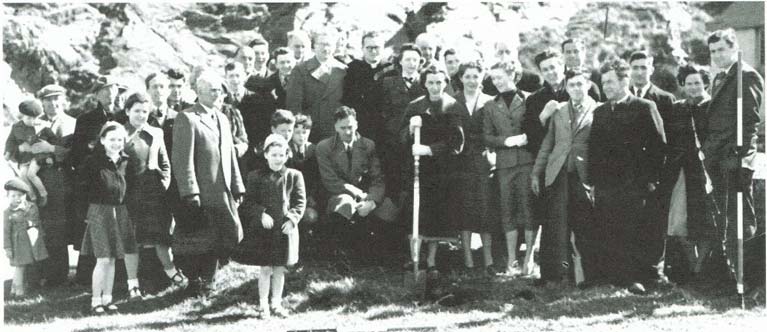 Beginnings – the ceremony to turn the first sod for the building of a clubhouse for the new Wicklow Sailing Club in 1953
Beginnings – the ceremony to turn the first sod for the building of a clubhouse for the new Wicklow Sailing Club in 1953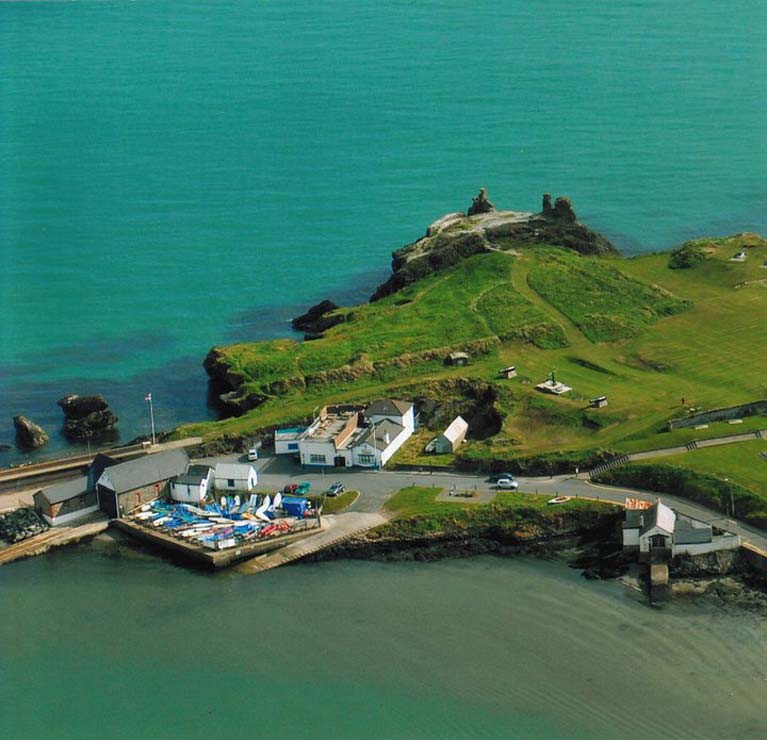 Small club, big heart – Wicklow SC (centre) and the Wicklow RNLI Station (left) provide a maritime hotspot at the head of the pier
Small club, big heart – Wicklow SC (centre) and the Wicklow RNLI Station (left) provide a maritime hotspot at the head of the pier
The organising Wicklow Sailing Club – founded as recently as 1950/51 - may have been small by comparison with many of the older history-laden Irish yacht clubs. But with a strong voluntary spirit, it punched well above its weight in being at the heart of a community in which it promoted sailing and waterfront co-operation in a picturesque but workaday port, a harbour where the dominant activities had formerly been in meeting the needs of small cargo ships, a local inshore fishing industry, and a voluntarily-supported lifeboat station.
By the late 1970s the club was a hive of activity, and in 1979 - with Harry Jordan as Commodore - in addition, its own busy weekly races it was actively involved in bringing newcomers to sailing. That year, it also ran an innovative Wicklow Yacht Rally which drew in 46 participants from all around the Irish Sea. With its testing of crews’ skills and a programme of assessment and advice by recognized experts on preparing boats for serious sea-going, it was the core event in a summer fixtures list of such varied, useful and yet enjoyable activity that the newly inaugurated “Sailing Club of the Year” competition in 1979 selected Wicklow SC to be its first winner.
But even as the successes of 1979 were being celebrated, another game-changing idea was rapidly developing. Michael Jones, a keen member of the club who served as Commodore three times - in 1972, 1984 and 1991 - was also a longtime honorary secretary of the Wicklow RNLI. With an accountancy practice in the town, he was well aware of the place’s strengths and weaknesses.
Pondering on all this, he became convinced that a major maritime event was needed to help Wicklow re-discover its deeper maritime roots, assert its individuality as a self-contained and thriving community in the face of growing Dublin commuter encroachment, and generally make its mark on the national sailing stage.
 Man of vision – Michael Jones of Wicklow
Man of vision – Michael Jones of Wicklow
Or at least that’s the way he subsequently explained how he brought the Round Ireland Yacht Race starting and finishing at Wicklow into being. Whatever the reasons, he had the idea, indeed he was consumed by it. But instead of promoting it with noisy announcements, he put at least as much energy into behind-the-scenes networking with the kind of slightly off-the-wall offshore sailing enthusiasts who had emerged with the growth of the ISORA programme and other events, together with more cruising-oriented people whom he knew would feel that a non-stop round Ireland race was an event whose time had come.
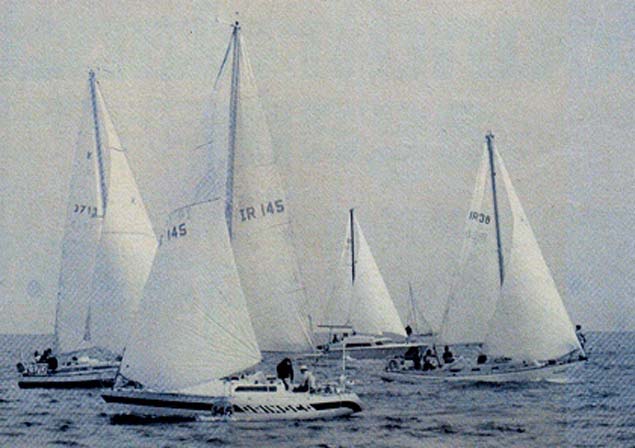 Pre-start manoeuvres at the inaugural Round Ireland 1980 with (left to right) line honours winner Force Tension, the Shamrock class Orinoco, John Hall’s Prout catamaran, and eventual overall winner Raasay of Melfort (Brian Coad). Photo: W M Nixon
Pre-start manoeuvres at the inaugural Round Ireland 1980 with (left to right) line honours winner Force Tension, the Shamrock class Orinoco, John Hall’s Prout catamaran, and eventual overall winner Raasay of Melfort (Brian Coad). Photo: W M Nixon
At the same time, he brought key members of Wicklow Sailing Club who had shown their readiness for voluntary work along with him, and the fruits of their labour became evident on that summery Saturday afternoon off Wicklow on June 28th 1980 when 13 boats went off southwards in an easterly breeze after a rather uneven start. It was uneven because this was the first time a Round Ireland fleet became aware that the sluicing ebb off the Wicklow pierheads makes an early arrival on the line a loser’s option.
Thus although top skipper Johnny Morris of Pwllheli with Tony Vernon’s High Tension 36 Force Tension was so neatly away that his boat doesn’t appear in any of the photos of the main group starting, Half Ton ace Jim Poole of the National Yacht Club with his Ron Holland-designed Feanor almost found himself on the wrong side of the Committee Boat in that tide, and had to assert his rights on starboard gybe to make the line.
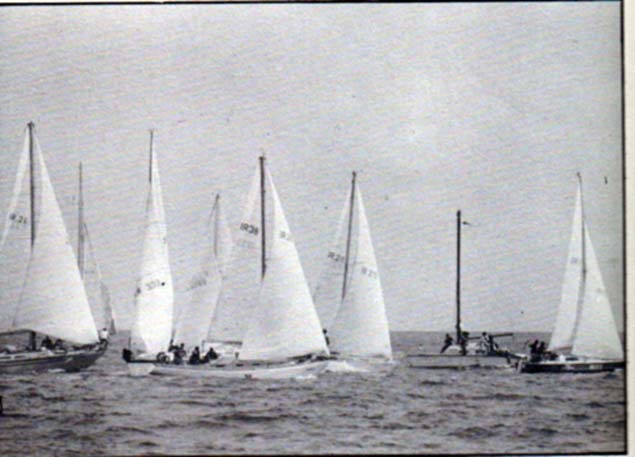 That first start in 1980 – Force Tension is already out of picture, Brian Murphy’s Hydra class Crazy Jane is next across ahead of Raasay, and Feanor is having to assert her starboard gybe rights with Partizan after under-estimating the tidal stream. Photo: W M Nixon
That first start in 1980 – Force Tension is already out of picture, Brian Murphy’s Hydra class Crazy Jane is next across ahead of Raasay, and Feanor is having to assert her starboard gybe rights with Partizan after under-estimating the tidal stream. Photo: W M Nixon
Yet in the end, although Force Tension took line honours by more than two hours from Dave FitzGerald’s Holman & Pye 41 Partizan from Galway, it was the little Feanor (whose crew included a young Enda O Coineen) which won IOR overall by an hour from Dermod Ryan’s Hustler 35 Red Velvet (RStGYC).
But when the idea of the race had been launched, Michael Jones had no idea of just how much it would appeal to an all-Ireland cross-section of established offshore racers. So, to spread the net wide, he announced from the get-go that the ultimate winner would be based not on the very competitively-oriented International Offshore Rule, but on a special Wicklow Round Ireland Handicap, and multi-hulls would also be welcome to take part.
 Making knots in the open Atlantic - the Half Tonner Feanor running smoothly off the west coast. Photo: Enda O Coineen
Making knots in the open Atlantic - the Half Tonner Feanor running smoothly off the west coast. Photo: Enda O Coineen Chasing the big ’uns – Feanor with the 41ft Partizan (Dave Fitzgerald) off the coast of Donegal in 1980. Photo: Enda O Coineen
Chasing the big ’uns – Feanor with the 41ft Partizan (Dave Fitzgerald) off the coast of Donegal in 1980. Photo: Enda O Coineen
Thus the first winner was definitely a boat with strong cruising emphasis, Brian Coad’s Rival 34 Raasay of Melfort from Dunmore East. And though none of the multihulls finished, one of their skippers, John Hall of the National YC, is the only skipper from that race of 1980 still actively campaigning, though for some years now he has been doing it in partnership with his son Brian in the J/109 Something Else.
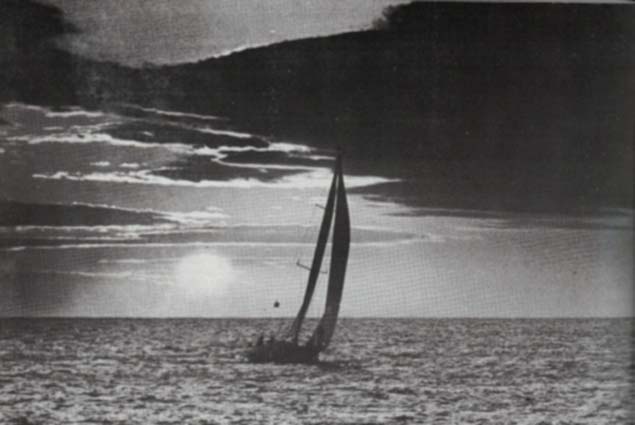 Classic finish to the first Round Ireland Race – Dave Fitzgerald’s Partizan from Galway come out of the dawn to the finish at Wicklow in 1980 to take second in line honours
Classic finish to the first Round Ireland Race – Dave Fitzgerald’s Partizan from Galway come out of the dawn to the finish at Wicklow in 1980 to take second in line honours
Either way, the race was well launched, and signs of addiction to this glorious course were well in evidence among some of the first time participants. So there was no question but that the race would be sailed again in 1982, and this time Michael Jones and his team in Wicklow SC really hit the jackpot - The Doyler came up from Crosshaven to take part with his already-legendary new Frers-designed 51ft Moonduster.
Denis Doyle and Moonduster epitomised the very spirit of Irish offshore racing, going back in a direct line to the Gull in the first Fastnet Race of 1925 with skipper Harry Donegan. Needless to say, in the time-honoured Cork sailing tradition the Doyle and Donegan families were related through marriage. Like Harry Donegan, Denis Doyle fully realised what a significant role a major sailing event could play in the economy of a small seaport town. So in Wicklow, Moonduster’s skipper and his ever-supportive wife Mary stayed near the harbour in a guesthouse in the town in the days beforehand to indicate their complete commitment to a Wicklow-based Round Ireland Yacht Race, a supportive habit they continued throughout Moonduster’s many years of racing round Ireland.
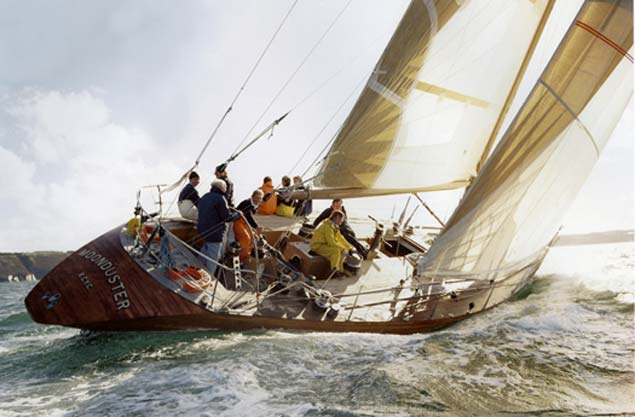 Denis Doyle helming his beloved Moonduster. His complete commitment to the Round Ireland Race as a Wicklow event from 1982 onwards played a key role in establishing the race’s success. Photo: Bob Bateman
Denis Doyle helming his beloved Moonduster. His complete commitment to the Round Ireland Race as a Wicklow event from 1982 onwards played a key role in establishing the race’s success. Photo: Bob Bateman
As a former Flag Officer of the Royal Ocean Racing Club, Moonduster’s skipper brought an element of RORC support to the event, particularly as regards pre-race scrutineering. This was very timely for the 1982 circuit, as it was a race of heavy weather with north to northeast gales making things brutal. Many boats sought shelter along the west coast, and even Moonduster had to pause for a while close under the limited shelter of Malin Head while a crewman went aloft to replace a broken halyard.
Despite that, she got round in 4 days 3 hrs 45mins and 25 seconds, taking line honours and eventually the overall win despite the slowly-changing wind direction theoretically favouring the smaller boats. As for the race’s status, it was now fully established in the offshore calendar in its convenient position in non-Fastnet years, with Moonduster becoming a round Ireland regular until Denis Doyle’s death in 2001.
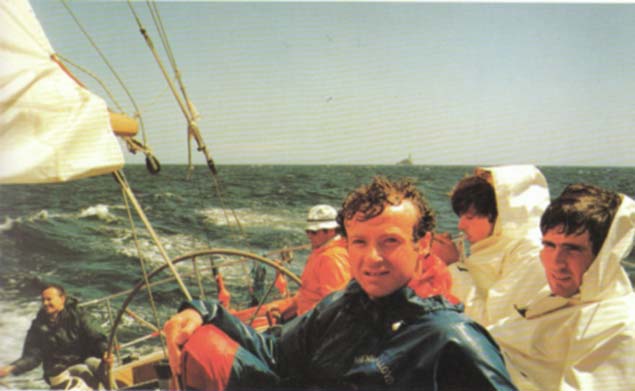 Neil Hegarty at the helm as Moonduster puts the Fastnet Rock rapidly astern in 1984’s record race – “we were seeing off an entire Irish county in every watch”.
Neil Hegarty at the helm as Moonduster puts the Fastnet Rock rapidly astern in 1984’s record race – “we were seeing off an entire Irish county in every watch”.
In 1984, The Duster had an astonishing race, with the wind favouring her at every headland such that, in the words of navigator John Bourke (who was himself later to become the RORC Commodore): “We were seeing off an entire Irish county in every watch”.
In 2020, forty years after that first tentative race, we’re looking at the 21st Round Ireland Race from Wicklow, and a bare tabulation of the winners over the years gives a hint of the many boats and hundreds – indeed thousands – of people who have been involved, people who in their most active offshore racing days defined this now-central feature of Irish sailing.
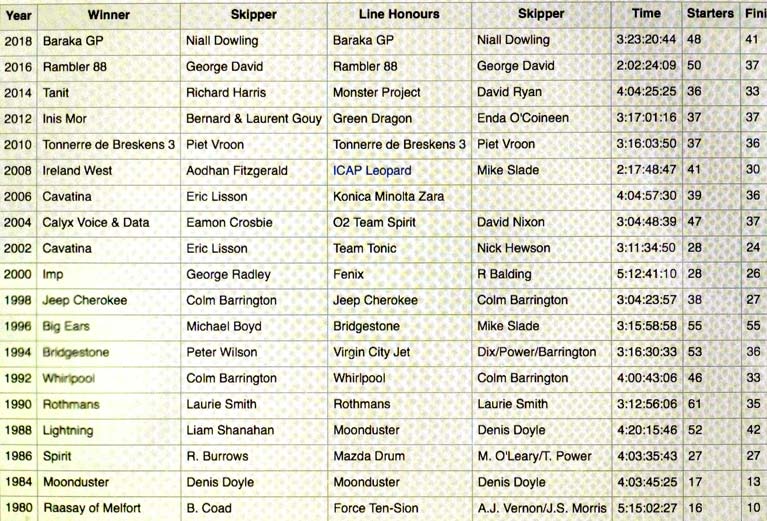 An almost-complete basic analysis – missing is 1982 when Moonduster took both line honours and the corrected time win, a feat she repeated in 1984.
An almost-complete basic analysis – missing is 1982 when Moonduster took both line honours and the corrected time win, a feat she repeated in 1984.
The stories behind this bare-bones list would fill several books and still leave out some choice stories. 1986 saw the race gain real muscle with major sponsorship from Cork Dry Gin, and in that year it was Irish Distillers own Richard Burrows himself who won (his crew including Robert Dix) sailing the Dehler db2s Spirit, while line honours were taken by the Ron Holland Maxi Drum, with owner Simon le Bon of Duran Duran on board.
The fact that all 27 starters finished reinforces memories of this as being one of the most summery races, but as Robert Dix on Spirit commented, “the summer haze was such that half the time we couldn’t see the magnificent coastlines which we knew we were racing along.
The special Dehler db2s got another look-in during 1988’s race, when Liam Shanahan’s Lightning (NYC) took the handicap win, while Moonduster had another bite at line honours. Those late 1980s were the last years in which tobacco and drink companies were still tolerated as sponsors for sports events. But the Health Police were closing in, and the Cork Dry Gin Round Ireland Race of 1990 was something of a last hurrah, as CDC’s generosity encouraged a starting line-up of 61 boats – it’s still the record turnout – and the line honours and overall winner was the legendary Lawrie Smith sailing the Maxi Rothmans and promoting Silk Cut cigarettes, his leading crew being the hyper-talented Gordon Maguire.
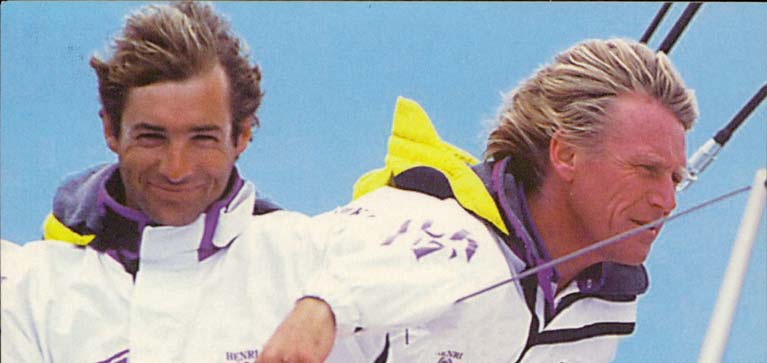 Dream team…Gordon Maguire and Lawrie Smith on the maxi Rothmans, with which they won line honours and overall in 1990’s race.
Dream team…Gordon Maguire and Lawrie Smith on the maxi Rothmans, with which they won line honours and overall in 1990’s race.
Yes indeed, boys and girls. Thirty years ago, ultra-healthy sports events such as the Round Ireland Race were being sponsored by booze companies and won by smokes, and only a few thought it all a bit odd. So the fact that for 2020 the new sponsor is a clean energy company which is hitting the optics spot on - and sending out all the right messages - tells us how far we’ve come in thirty years, even if in the end it is still the same rugged challenge of getting your boat round Ireland in a competitive timeframe.
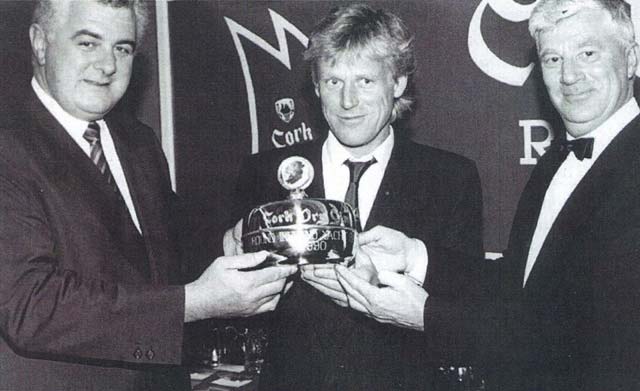 Richard Burrows (winner in 1986) with Lawrie Smith (winner in 1990) and Race Director Michael Jones
Richard Burrows (winner in 1986) with Lawrie Smith (winner in 1990) and Race Director Michael Jones
In fact, in looking at that list, you can deduce from comparing the number of finishers with the number of starters just how rough that particular race might have been, for if the race had been beset by calm, the high-rated boats tended to suffer but low-rated craft like Eric Lisson’s Noray 38 Cavatina from Cork – winner in 2002 and 2006 – knew they just had to keep plodding along and read the new wind correctly to take the honours.
If the 1980s were the era of the Dehler db2S marque, the 1990s marked high noon for the J/35. Not every boat from the generally successful J Boat range was always on the money, but even among the special ones the J/35 was very special indeed, and in 1994 (quite a stormy race) Peter Wilson of Howth won with the J/35 Bridgestone, while in the 1996 race it was the turn of a sister-ship, Big Ears from the RIYC skippered by future RORC Commodore Michael Boyd, which took the honours.
Michael Boyd’s dedication to racing round Ireland is quite something, as he’s still at it, and with good placings in the 2016 and 2018 races he is well in line for the three-race prize of a Volvo car, presumably one of the impressive new electric ones. But though the whispers for the 2020 strongly suggest a Boyd involvement, at the moment nothing is official.
Meanwhile, we could warble on for hours about what that list of winners and line honours holders tells us, but for now, we’ll be content with observing that the last truly Irish overall winner was Aodhan FitzGerald of Galway with the First 40.7 Ireland West in 2008, which is getting to be quite a long time ago.
Admittedly the most recent winner in 2018, the Ker 43 Baraka GP, was entered by Niall Dowling of the RIYC, and his navigator/tactician was our own Ian Moore, but they’re both now essentially Solent-based, as is the chartered boat. That said, perhaps we should run with the notion that the modern Irish diaspora is a matter of success and achievement which can be applied anywhere in the world.
Be that as it may, since Ireland West’s win in 2008, the internationalism of the Round Ireland Race has been underlined by the fact that the subsequent winners have been from The Netherlands (Tonnere de Breskens 3, 2010), France (Inis Mor 2012), Scotland (Tanit, 2014) and the USA (Rambler 88, 2016).
 Wicklow Sailing Club Commodores – the size of the membership can be gauged from the fact that some Commodores served more than one spell of duty, with Michael Jones filling the role three times
Wicklow Sailing Club Commodores – the size of the membership can be gauged from the fact that some Commodores served more than one spell of duty, with Michael Jones filling the role three times
From an organiser’s point of view, this is a very satisfactory state of affairs, but it does mean that the workload of running the race has increased exponentially. Michael Jones carried the torch as Race Director from 1980 until 1992, then from 1994 to 1998, Fergus O’Conchobhair took up the reins. He was succeeded by Denis Noonan from 2000 until 2010 when Theo Phelan took over.
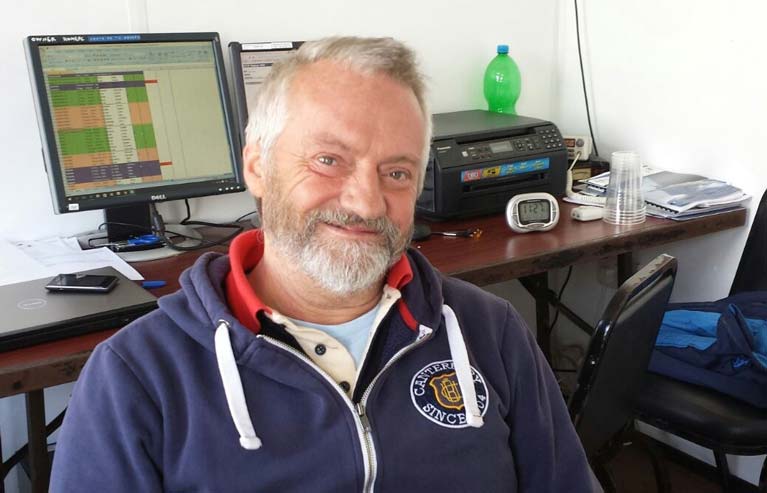 Fergus O’Conchobair was Race Director from 1994 to 1998
Fergus O’Conchobair was Race Director from 1994 to 1998
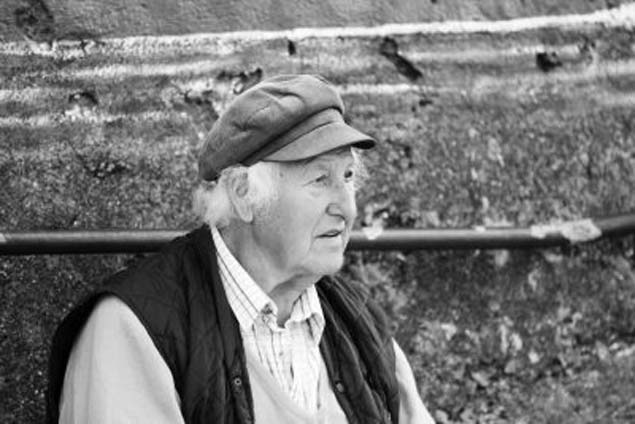 Denis Noonan organised six Round Ireland Races between 2000 and 2010.
Denis Noonan organised six Round Ireland Races between 2000 and 2010.
The effects of the economic recession were hitting very hard as the 2012 race approached, but Theo hung in with total dedication to keep it alive, and it was he who came up the concept of a link to the Royal Irish YC in Dun Laoghaire in time for 2014’s race, which served the big boats particularly well in 2016. Theo in turn retired in February 2018 with Hal Fitzgerald taking over for that year’s race, while for 2020 there has been a spreading of the workload with Hal continuing as Race Director but basically in the demanding backroom role, while the promotional aspects have been taken on by former WSC Commodore Denise Cummins and current Commodore Kyran O’Grady.
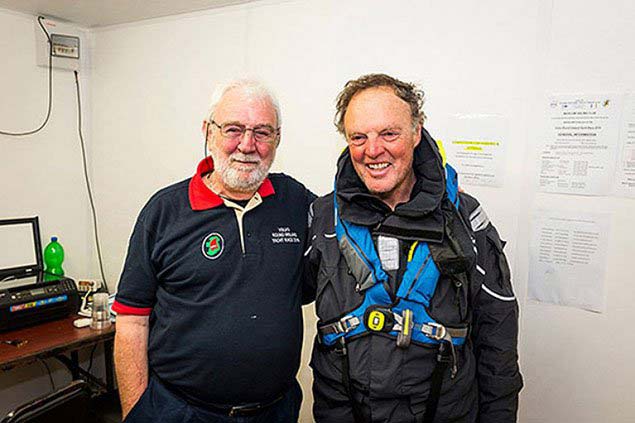 Theo Phelan with Michael Boyd, Commodore RORC, when the latter concluded his second Round Ireland Race in 2016, twenty years after winning overall in 1986
Theo Phelan with Michael Boyd, Commodore RORC, when the latter concluded his second Round Ireland Race in 2016, twenty years after winning overall in 1986 Hal Fitzgerald, a former Commodore of WSC, has been Race Director since 2018
Hal Fitzgerald, a former Commodore of WSC, has been Race Director since 2018
This new setup makes sense because, successful and all as the Round Ireland race has become, it is operating in an increasingly challenging market, with 2020’s plethora of major anniversaries in Irish sailing providing several rival attractions. Thus the Wicklow folk have to spread their international message, and the French market, in particular, has been targeted, with promotional visits to the Paris Boat Show in December (where they received support from offshore superstar Charles Caudrellier), and then in January, Kyran O’Grady was invited to give an event presentation at the annual gala prize-giving of UNCL, the French equivalent to the RORC.
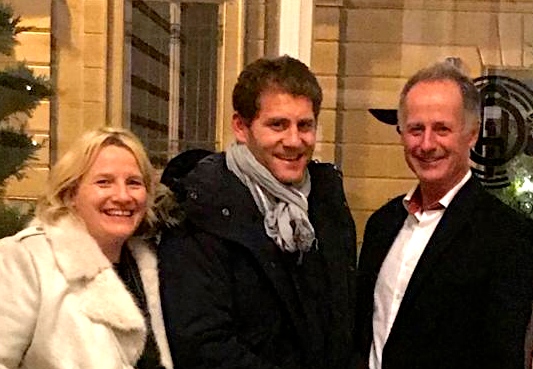 International promotion. Former WSC Commodore Denise Cummins, France’s Yachtsman of the Year Charles Caudrellier, and WSC Commodore Kyran O’Grady at the Paris Boat Show in December.
International promotion. Former WSC Commodore Denise Cummins, France’s Yachtsman of the Year Charles Caudrellier, and WSC Commodore Kyran O’Grady at the Paris Boat Show in December.
But while the backbone of the SSE Renewables Round Ireland Race in 2020 will continue to be fully-crewed IRC boats, the race also caters for a growing number of Class 40s which find the course well suited to their needs, while as ever Multi-hulls are very welcome and the two-handed division is increasingly significant, particularly if there’s a new emphasis on having female/male crews in line with the thinking towards the new class in the 2024 Olympics.
At the other extreme, after the 1937-built classic Maybird (Darryl Hughes) became the first gaff-rigged boats and the oldest ever to complete the Round Ireland course in 2018, the newly-instated Maybird Mast trophy will honour the race’s most senior boat.
 The clean way ahead, WSC Commodore Kyran O’Grady with Barry Kilcline of SSE Renewables after agreement had been reached for SSE to sponsor the Round Ireland Race. Photo courtesy WSC
The clean way ahead, WSC Commodore Kyran O’Grady with Barry Kilcline of SSE Renewables after agreement had been reached for SSE to sponsor the Round Ireland Race. Photo courtesy WSC
Thus the challenge of racing round Ireland retains its timeless attraction, but how you take it on is something which is constantly being modified and updated by the team in Wicklow Sailing Club. They’re so busy getting on with it that they scarcely seem to notice the prodigious amount of voluntary work which is necessary to keep this unique show on the road. As for the rest of us, we can best acknowledge this by realising that an Irish sailing CV isn’t really complete without at least one Round Ireland Race in its list of achieved projects.
Round Ireland Yacht Race Promoted at UNCL Prizegiving in Paris
SSE Renewables Round Ireland Race organiser Kyran O'Grady led a Wicklow Sailing Club delegation to France in December to address the Union Nationale pour la Course au Large (UNCL) prizegiving in Paris.
Keen to encourage French and international numbers for this year's biennial Irish offshore classic in June, the Wicklow Commodore also revealed a special draw prize for foreign boats coming to Ireland this summer.
Using impressive visuals from from the race, O'Grady took the opportunity to point out the unique features of the 700-miler that celebrates its 21st edition in 2020. "Not alone do you go around the Fastnet Rock but also around Ireland with for tidal gates, the Open Atlantic Ocean on the west coast before coming very close to Scotland and a finish further down the Irish Sea and a warm welcome back in Wicklow," he told the important French gathering.
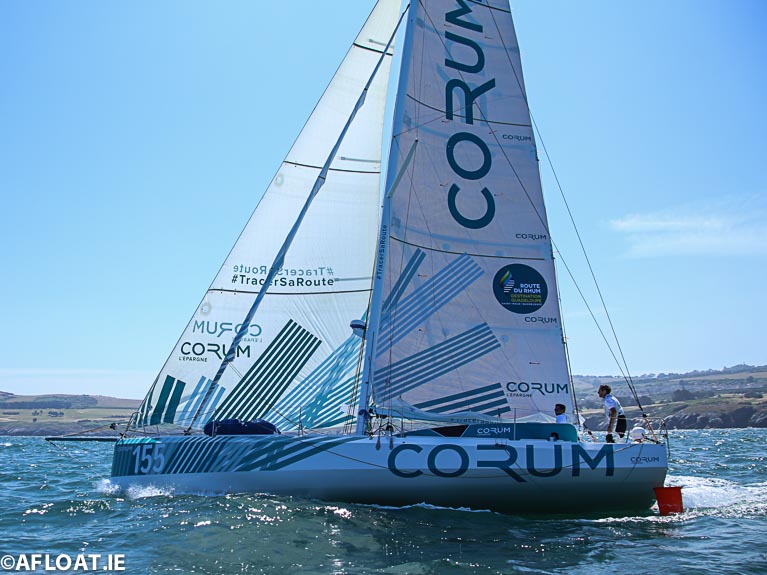 In the 2018 Round Ireland Race, The French Mach 40 had three French sailing stars onboard Nicolas Troussel, Ian Lipinski and Aymeric Belloir for the circuit Photo: Afloat
In the 2018 Round Ireland Race, The French Mach 40 had three French sailing stars onboard Nicolas Troussel, Ian Lipinski and Aymeric Belloir for the circuit Photo: Afloat
In co-operation with the British offshore racing club, RORC, UNCL is responsible for IRC, the principal international handicap system for yacht racing.
O'Grady also announced that French boats that enter both the Round Ireland Race in June and July's Cork Week Regatta in Cork Harbour will be entered into a draw for a case of Irish whiskey from Irish Distillers.
Entry in the 2020 Round Ireland Race is expected to open on January 20th with the race organisers already announcing the leaderboard for the Volvo Car Prize and a new trophy for the oldest boat in the race.
What Are The Big Irish Sailing Fixtures for IRC Cruisers in 2020?
Irish Olympic helmsman Mark Mansfield picks his big (and smaller) events coming up for the Irish cruiser classes in 2020
The 2019 season is only just coming towards its end and already owners and crew are looking ahead at what is in store next year. There are still some good events to finish this season, and among them, the Autumn Leagues in Howth and Royal Cork, The final ISORA race, with the spoils still not decided, the J109 Nationals, the final summer series DBSC races and of course the very popular DBSC Turkey Shoot series.
2019 was very much a front-loaded year with Scottish Series, ICRA Nationals, Dun Laoghaire to Dingle Race, Sovereigns Cup and Dun Laoghaire Regatta all happening within a seven-week period, and 2020 is not looking a whole lot different.
Below you will see the dates of the bigger events for 2020.
Without a doubt the two standout big boat events next year will be the Round Ireland Race in June and in July, Royal Cork Yacht Club host their special Cork Week, on the Munster club's 300th year anniversary. More on this later.
2020 'Big Boat' events
- Scottish Series, Tarbert - May 22nd to May 25th (Friday to Monday)
- Wave Regatta, Howth Yacht Club - May 29th to May 31st (Friday to Sunday)
- Round Ireland Race, Wicklow SC - Starts June 20th (Saturday)
- RORC Morgan Cup - Cowes to Cork - Starts July 8th (Wednesday)
- Cork Week, Royal Cork Yacht Club (300 Year Celebration) - July 13th to July 18th (Monday to Saturday)
- Calves Week - Schul August 4th to August 7th - (Tuesday to Friday)
Other events that are building numbers are Bangor Week, commencing 25th of June and WIORA week (date not published yet). The very popular ISORA offshore series runs throughout the year and these dates are also eagerly awaited.
Here are some details of each of the larger events:
Scottish Series
Always a very happy hunting ground for Irish boats wishing to sharpen themselves up for the new season. Numbers generally have been dropping for the Scottish Series except for the very popular RC35 class where Irish Boats took all podium places this year. Class 2 in 2020 might also show some increases with the biennial Classic Half-Ton Cup in Cowes bringing the competitive Half Tonners out to play early. This year there were two half tonners—expect more in 2020. Great racing and great pub craic around the beer tent and local pubs.
 Irish Boats at 2019 Scottish series RC 35 class Photo: Marc Turner
Irish Boats at 2019 Scottish series RC 35 class Photo: Marc Turner
Wave Regatta
Only a new event in 2018 and is based around the Howth Yacht Club traditional June Bank Holiday Lambay Race. Wave Regatta is held every two years and if 2018 is anything to go by, it will be very well attended in 2020. It comes just a few days after the end of Scottish Series. A variety of courses over the three days, including the very popular round Lambay race. Well organised with great onshore facilities.
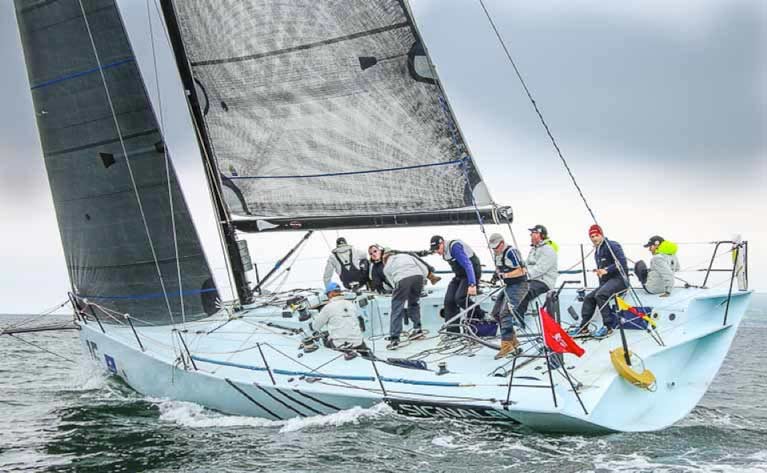 Jamie Mc William's Ker 40, Signal 8 at Howth's Wave Regatta 2018 Photo: Afloat
Jamie Mc William's Ker 40, Signal 8 at Howth's Wave Regatta 2018 Photo: Afloat
Round Ireland Race
The big one. 704 miles from Wicklow to Wicklow, clockwise around Ireland and its islands, turning corners all the way around. It goes from strength to strength. There is a rumour of a very large, very well known Maxi looking at taking on the challenge and the record in 2020. If you only plan to do one full-length offshore race, this is the one to do. I have done five Fastnet Races and I would always pick a Round Ireland over a Fastnet.
For those boats who have competed in the last two events, there is the added bonus of the chance to win a Volvo car for the best Boat over the 2016, 2018 and 2020 races. I’m sure we will be advised of the current pecking order very soon on this.
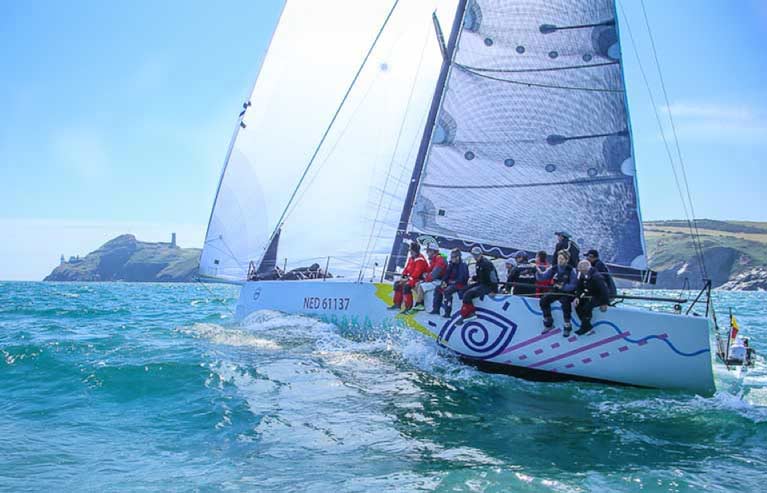 Niall Dowling's Royal Irish Yacht club, Ker 43, Baraka GP, the overall winner of the Round Ireland 2018 Photo: Afloat
Niall Dowling's Royal Irish Yacht club, Ker 43, Baraka GP, the overall winner of the Round Ireland 2018 Photo: Afloat
RORC's Morgan Cup
Rarely do Flagship RORC races end in Ireland, but on the 300th year anniversary of the founding of the Royal Cork Yacht Club, the RORC have graciously organised for one of their big races to finish in Cork, as a way of getting UK boats over for the Cork Week 300 regatta.
Approx 90 boats competed in the 2019 Morgan Cup edition this year, won overall by a J109. I suspect you may see some offshore orientated Irish boats decide to include this race in their calendar next year, which also serves as a way to get the boat to Cork in time for the Cork Week 300 Series.
Cork Week 300
From the Height of Cork Week in 2000 when boats competing topped 700, it has fallen somewhat. However, 2020, the 300th Anniversary of the club's founding, is all set to be special and interest from all corners of the world is evident with housing around Crosshaven and Carrigaline already starting to be booked up.
A number of classes are planning to use the week as their European Championships. The 1720 class, who had circa 75 boats at their 2000 event, are planning a big show in 2020 with already 10 boats confirmed from the UK with more likely to follow. A proper event Announcement is expected in September announcing some major classes and profile boats that will be competing.
The 2020 ICRA Nationals is being held as part of Cork week (three days only). Cork Week also incorporates a building fleet for the Beaufort Cup, which is a separate event within the week for associated national services (Army, Naval, Police, Firefighting, Coast Guard etc). This event incorporates an offshore race around the Fastnet and back.
Cork Week 2020 will be one not to miss. White Sail and coastal fleets will be included and the highlight is the all in Harbour race.
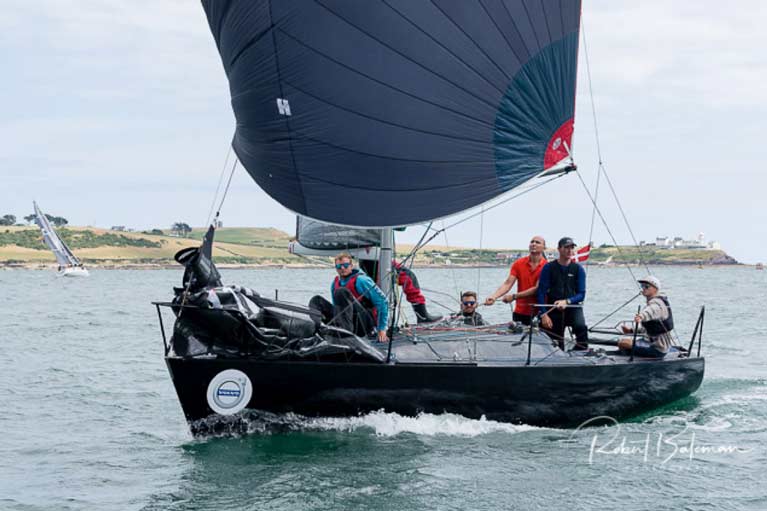 Rory Fekkes from Carrigfergus SC, First Class 8—FN-GR8—Overall Winner of Cork week 2018 Photo: Bob Bateman
Rory Fekkes from Carrigfergus SC, First Class 8—FN-GR8—Overall Winner of Cork week 2018 Photo: Bob Bateman
Calves Week
Numbers have held up very well for Calves Week. In 2019, there were 65 cruisers competing, with very competitive racing over the four days. A mix of windward-leeward courses, around the Islands and the Fastnet race keeps everyone interested. One race a day, with all the crews congregating after racing out in the streets between Newmans and Hackett's pubs. The Apres racing is as important as the racing with many sailors choosing to incorporate family holidays into the week. If you are doing Cork Week, and have not done Calves Week before, maybe you should consider leaving the boat in Cork and sliding down westwards a week or two later.
 Paul O'Higgins Rockabill VI from the Royal Irish—Winner of Calves week Class One in 2019
Paul O'Higgins Rockabill VI from the Royal Irish—Winner of Calves week Class One in 2019
Maybird Round Ireland show on Tuesday at DBOGA Poolbeg Cancelled
The talk by Darryl Hughes of his veteran gaff ketch Maybird’s much-celebrated participation in the Volvo Round Ireland Race 2018, to be hosted by the Dublin Bay Old Gaffers Association at Poolbeg Yacht & Boat Club on Tuesday 12th March, has been cancelled owing to the sudden serious illness of Darryl’s mother in North Wales. It is hoped to re-schedule the show in due course.
How Military Principles Helped the Defence Forces Win in Sailing in 2018
It was while crossing the Atlantic on the Sail Training Brigantine Asgard II during a celestial navigation module of his Naval Service education in 1999 that Barry Byrne had something of an epiphany writes W M Nixon. He’d been introduced to sailing through the welcoming approach of Wicklow Sailing Club in his home town. This led on to joining the Naval Service after he left school.
The thought of transferring to the Army had arisen. Yet it took a long voyage on Asgard II to make the decision for him. His enjoyment of it gave him back his love of sailing and he considered that maybe a career at sea might not be conducive to continuing sailing as a sport.
Thus he changed course, transferring to the Army and a successful career in which he has specialized in technology and served with the UN in peacekeeping missions throughout the world, rising to the rank of Commandant.
In sailing, Barry and his team in the 704-mile Volvo Round Ireland Race 2018 won the Corinthian Class and placed second overall, and then went on to successfully defend the highly competitive Beaufort Cup in Cork Week just two weeks later.
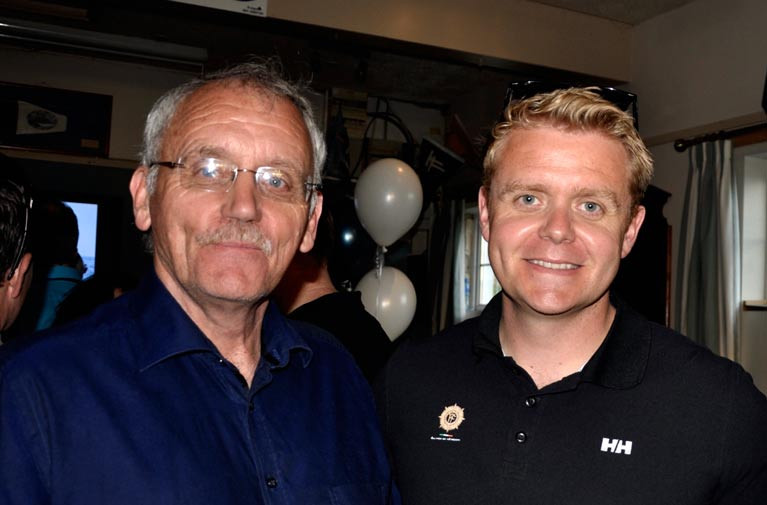 Barry Byrne (right) with his father Shea at Wicklow Sailing Club’s celebration of becoming Mitsubishi Motors “Sailing Club of the Year” 2017. Barry’s captaining of the team which won the inaugural Beaufort Cup in 2016 played a key role in Wicklow SC’s year of achievement. Photo: Angela Higgins
Barry Byrne (right) with his father Shea at Wicklow Sailing Club’s celebration of becoming Mitsubishi Motors “Sailing Club of the Year” 2017. Barry’s captaining of the team which won the inaugural Beaufort Cup in 2016 played a key role in Wicklow SC’s year of achievement. Photo: Angela Higgins
Currently doing an intensive Masters degree in Leadership and Management in the military Staff College at The Curragh, he reflects on how military principles served his team well during last year’s sailing campaign.
While many top sailors achieve success by using proven business administration and motivational means, Commandant Byrne shares the ways in which the success of the J/109 Joker II and her crew might stand up to classic military analysis. He sets the scene:
“Half of the team that competed in the Round Ireland (June 30th) and Cork Week/Beaufort Cup (starting July 16th) had never sailed together before. Like many of us, I had just returned from overseas service with the United Nations in February. We had very little time to put together a campaign aimed at winning two of Ireland’s premier competitions. For this, we used military principles.
Plans are nothing, but planning is everything
General Dwight D Eisenhower is credited with this statement. The point here is that no plan survives first contact with the enemy (or the West Coast of Ireland in a rugged mood). But if you have been through an effective planning process, it will stand to you. We used the Military Decision Making Process (MDMP) and Mission Analysis, essentially breaking down the mission ahead of us by factor, deduction and task. This helped in allocating clear areas of responsibility and job ownership in a short timeframe.
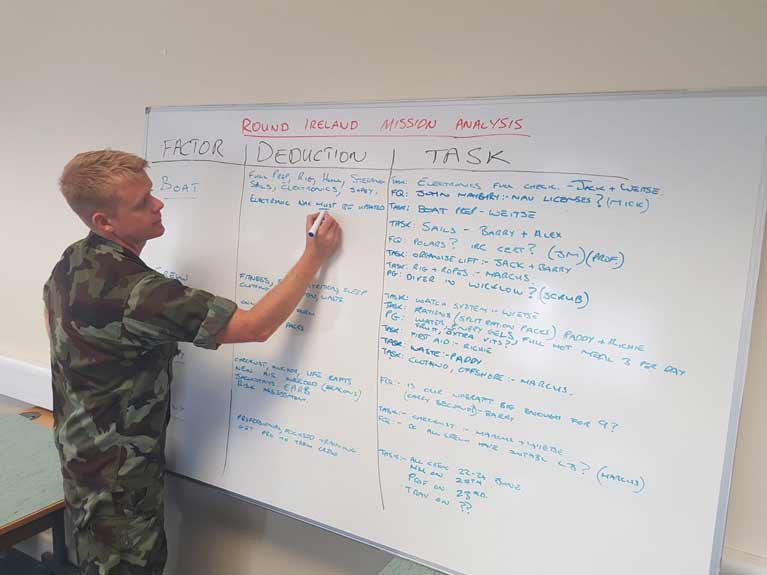 It may seem a long way from racing the Atlantic, but a proper Mission Analysis beforehand set the time-limited preparations on the right trac
It may seem a long way from racing the Atlantic, but a proper Mission Analysis beforehand set the time-limited preparations on the right trac
SMART Goals
The first event was the Volvo Round Ireland, and we set ourselves the goal of winning the inaugural Halpin Trophy, the armed forces trophy introduced by Wicklow Sailing Club. We would be up against international military teams, most notably the semi-professional British Soldier team who had their own race yacht, the X41 British Soldier, which went on to win the RORC annual series. We used the principle of SMART goals, with which many readers will be familiar (Editors' Note: SMART is Specific, Measurable, Attainable, Relevant and Timely). This was an ambitious target, but we assessed it as achievable and it focused our efforts.
Weapon of Choice
There is no point assembling a team if you do not have the tools for the job, and thanks to John Maybury, we had our weapon of choice; the seasoned and very successful J109 Joker 2. John is himself an inspirational leader. He is very supportive of the Defence Forces, indeed some of his own crew of longtime friends have enduring connections to the three services.
Focused Training
The training we completed on Joker2 in such a short time had to be very specific. Every training session had a clearly defined goal and timeframe, and we conducted After Action Reviews following every session. We also enlisted the help of a professional coach, Mark Mansfield, who gave our training focus and direction and was a valuable source of knowledge on J109 rig set up. Mark’s experienced insights on the Cork coastal area were particularly helpful in the Beaufort Cup.
 Mark Mansfield in racing mode. The former Olympic sailor and all-Ireland champion provided valuable insights for the Defence Forces’ crew in intensive training and rig-tuning sessions
Mark Mansfield in racing mode. The former Olympic sailor and all-Ireland champion provided valuable insights for the Defence Forces’ crew in intensive training and rig-tuning sessions
Logistics
Much of the preparation involved getting the boat ready. Getting to the start line of a challenging Cat 3 Offshore Race is a marathon in itself. The safety regulations your boat must pass and the training - such as sea survival - is substantial. Clearly defined areas of responsibility (which emerged from our mission analysis) were key.
One secret weapon we had was Flight Sergeant Adrian Mulligan, an aircraft technician who led much of the boat preparation, particularly regarding instruments. Unfortunately, Adrian suffered a back injury prior to the race. Exemplifying the Defence Forces values of loyalty and selflessness, instead of dropping off the campaign completely, he actually increased his contribution shoreside to compensate for being unable to sail.
 One of the pre-race preparation areas given special attention was nutrition, food and water. The Military Ration Packs may not be some people’s idea of haute cuisine, but they were exactly what was needed.
One of the pre-race preparation areas given special attention was nutrition, food and water. The Military Ration Packs may not be some people’s idea of haute cuisine, but they were exactly what was needed.
He brought another technical member of our race crew, Captain Wietse Buwalda, up to speed with all the instrumentation and power systems on the boat. This was later to prove vital in our success on the water. Other areas we focused on were nutrition, food and water. We had exactly the right amount of high energy military ration pack food, with Sergeant Paddy McGrath and Lt Richie O’Hagan leading the charge here.
Mission command
Another military principle is mission command. You pick the right person for a job and tell them what needs to be done, but not how to do it. A good friend, Captain Mick Liddy, was my navigator just as I had been his navigator on the last Round Ireland we did together. My brief to Mick was to win the Round Ireland… beyond this, I didn’t second guess him.
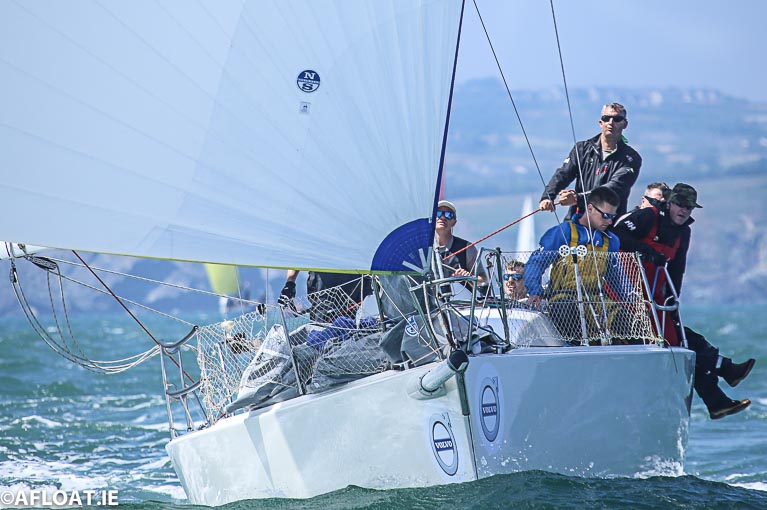 While every crewmember had a primary role, they also took on many other tasks – here, navigator Mick Liddy is on trimming duties shortly after the start.
While every crewmember had a primary role, they also took on many other tasks – here, navigator Mick Liddy is on trimming duties shortly after the start.
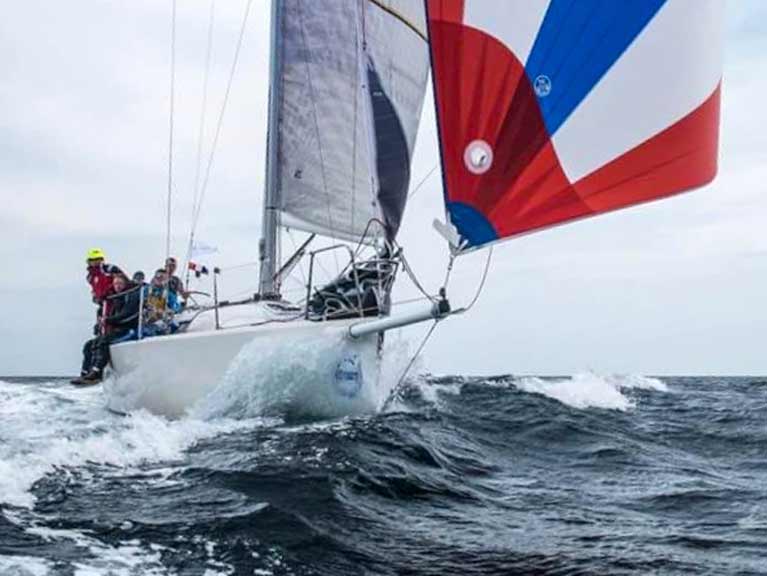 When the going was good. As seen from one of the French competitors, although the sun may not be shining, Joker II is making excellent progress along the south coast.
When the going was good. As seen from one of the French competitors, although the sun may not be shining, Joker II is making excellent progress along the south coast.
When we were off the West Coast in those extremely strong and very persistent north to northeast winds which kick up seas of special viciousness, we were way, way, further West than any other team on the racecourse. Joker 2 was enduring the worst of the weather in the hope of being first to find a suggested slight backing of the breeze. It has to be admitted my resolve was tested, but I’m glad to say I managed to keep my mouth shut. A team in the most recent Volvo Ocean Race fell foul of this inter-personal hazard, with the skipper and navigator second-guessing each other, which ultimately led to an overall slowing down and a harsh lesson for themselves and other offshore campaigners.
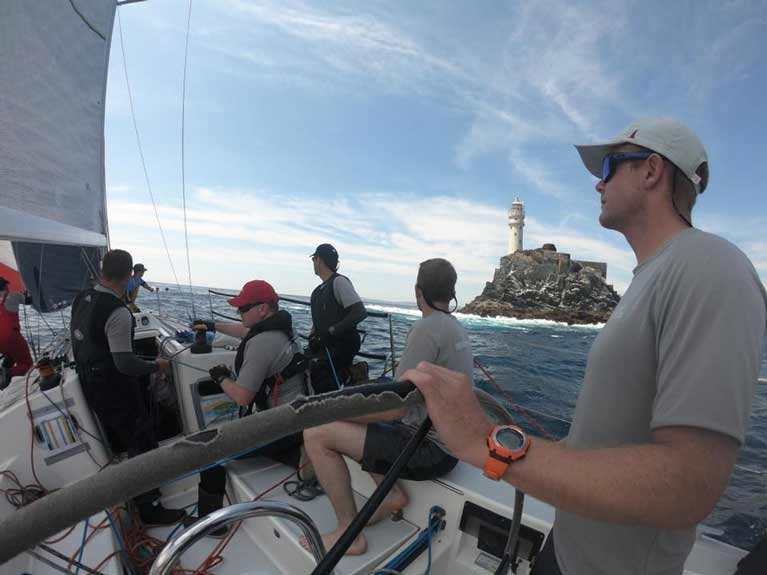 Joker II reaches the Fastnet Rock – the sky may still be blue, but those ominous cloud streaks to the west hint at the fierce headwinds in prospect
Joker II reaches the Fastnet Rock – the sky may still be blue, but those ominous cloud streaks to the west hint at the fierce headwinds in prospect
Values
Our rough-and-then-some experiences far out to the westward further tested other areas of character.
The Defence Forces core values are Respect, Loyalty, Selflessness, Physical Courage, Moral Courage and Integrity. I saw all of these when things got difficult on the West Coast. Due to a sudden diesel leak and the violent conditions, the interior of the boat had become a hellhole and the cause of seasickness among those who had never succumbed before.
Far from strengthening and sustaining ourselves with all those carefully-selected rations, the team could not even keep water down without vomiting, yet everyone dug deep. Mick and I bailed the diesel out of the bilge with a rag and bucket while the boat was slamming into 35 knots of wind. We trusted the team to run the show while the skipper and nav were down there for several hours. My routine was to fill a bucket of sea-watery diesel, empty it over the side, vomit, go back down and fill another bucket. Every member of the crew was a leader that day. Everyone stayed on the rail. Even at 3 am, team members who had not eaten in 30 hours and were continually being drenched to the core with ice cold Atlantic waves, were volunteering to rotate to the bow.
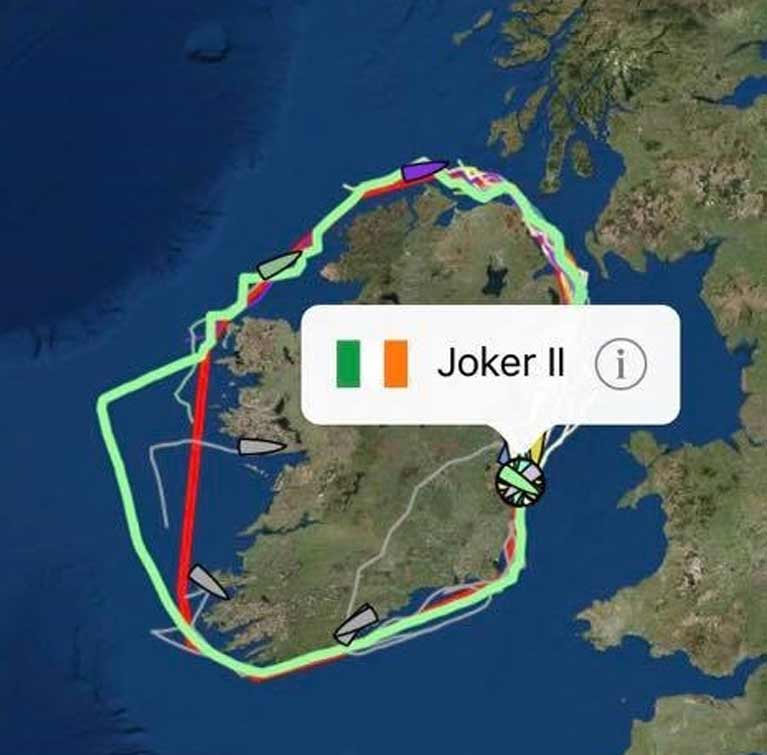 Most crews go off in the Round Ireland Race expecting a fast run down the west coast. But for 2018’s Race, the Atlantic was in a vicious mood with strong to gale northerlies, and Joker II went far to the west in the hope of finding a backing of the breeze suggested by some forecasts. It was a tactic by which they neither gained nor lost, but up off Donegal as the wind slackened, they made some good choices which put them well into the hunt.
Most crews go off in the Round Ireland Race expecting a fast run down the west coast. But for 2018’s Race, the Atlantic was in a vicious mood with strong to gale northerlies, and Joker II went far to the west in the hope of finding a backing of the breeze suggested by some forecasts. It was a tactic by which they neither gained nor lost, but up off Donegal as the wind slackened, they made some good choices which put them well into the hunt.
It was a brutal two nights. Just a few miles from us, a crew had rescued one of their team who had gone overboard in pitch black horrific conditions. (Editor’s Note: In the stream of information coming through from the Round Ireland fleet, the J/109 Jedi, skippered by Michael Boyd with Kenneth Rumball of Irish National Sailing School as first mate, tersely reported an MOB situation. But very quickly, they followed it with a brief message to the effect that the man overboard was retrieved, there were no injuries, and they were immediately resuming the race. This calm approach was so redolent of the best traditions of offshore racing that the incident became just one of many in a tough race. But happily at the RORC Annual Prize Giving in London in November, that briefly-recorded achievement in the Atlantic received the special recognition it deserved, with Michael Boyd and Kenneth Rumball being awarded the RORC’s Seamanship Trophy).
Barry Byrne continues: While this kind of offshore sailing may sound grim, even dangerous, it is precisely why we do adventurous training in the military; to test leaders at all levels.
My dad always says there are no atheists in a foxhole. I don’t think there was an atheist on Joker 2 that night either. Not when we were in the thick of it, nor when we eventually converged with the fleet off northwest Mayo and checked to see where we had ended up in the rankings. Once we’d crossed Donegal Bay, our navigator continued to resist the temptation to hug the coast, and we were looking good approaching Tory Island.
The Final Stages
When the wind eventually eased, it did the worst possible thing - it died completely. Teams were left in tortuous drifting conditions off the North Coast of Ireland where tides would frequently send you backwards at five knots if local seabed conditions or sheer depth of water prevented kedging.
During this particularly trying time, our electronic instruments died completely, thanks to having taken such a hammering off the West Coast. But Captain Wietse Buwalda, a communications officer, who - as mentioned already - had closely studied the electronic systems with Flight Sergeant Adrian Mulligan prior to the race, effectively rebuilt the system in about four hours of relentless work.
 When it all started to come right – having finally escaped from the North Coast, Joker II makes good progress down the Irish Sea
When it all started to come right – having finally escaped from the North Coast, Joker II makes good progress down the Irish Sea
As all this went on, a minke whale followed our boat for about 24 hours. I’m not sure if we were delirious with tiredness, but superstition got the better of us, and we took to sacrificing our tastiest treats from our ration packs to Minkie in the hope he would send some wind…
 One of the most difficult stages was the final 15 miles, with the wind drawing ahead and total concentration needed to get the best out of the boat
One of the most difficult stages was the final 15 miles, with the wind drawing ahead and total concentration needed to get the best out of the boat
And - eventually – he did. We escaped the North Coast with a great spin down the East Coast in twenty knots of favourable breeze. But about fifteen miles from the finish line, we encountered yet more drifting conditions and a nail-biting finish after five days of nonstop racing and minimal sleep. Finally, we got there. The legendary welcome in the wonderful Wicklow Sailing Club was everything I had remembered in previous races.
The fact that we collected the Halpin Trophy meant Mission Accomplished, so it was icing on the cake to get first in the Corinthian Division, first Irish boat and place second overall, in all coming first in four divisions of the 56-strong international fleet of the Volvo Round Ireland Race 2018.
 Military principles and values achieve the desired result
Military principles and values achieve the desired result
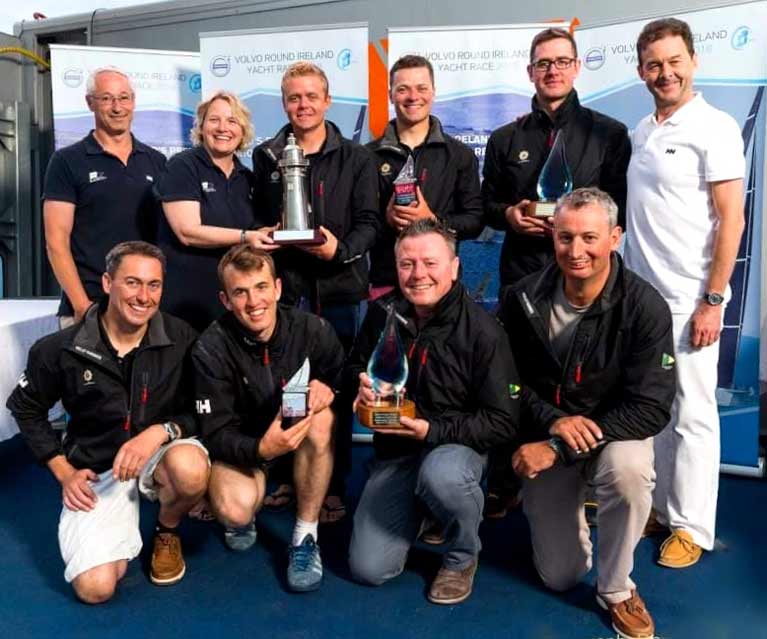 Prize-giving for Joker 2 at Wicklow at the conclusion of the Volvo Round Ireland Race with (back row, left to right) Hal Fitzgerald (Race Director), Denise Cummins (Commodore Wicklow SC), Commandant Barry Byrne, Lt. Alexander Rumball, Capt. Wietse Buwalda and David Thomas of Volvo Car Ireland. Front row (l to r) Cdr Brian Mathews (Commodore Defence Forces SC), Ens. Marcus Ryan, Sgt. Patrick McGrath, and Capt Mick Liddy (Rtd).
Prize-giving for Joker 2 at Wicklow at the conclusion of the Volvo Round Ireland Race with (back row, left to right) Hal Fitzgerald (Race Director), Denise Cummins (Commodore Wicklow SC), Commandant Barry Byrne, Lt. Alexander Rumball, Capt. Wietse Buwalda and David Thomas of Volvo Car Ireland. Front row (l to r) Cdr Brian Mathews (Commodore Defence Forces SC), Ens. Marcus Ryan, Sgt. Patrick McGrath, and Capt Mick Liddy (Rtd).
Beaufort Cup
It was a hectic turnaround to get the boat ready for the Beaufort Cup in Cork just two weeks later. This was made even busier as I am involved with running the series itself and liaising with all the visiting teams. This was the second iteration of the event, and it was a huge success, involving 160 competitors and 30 Defence Forces sailors, making up 16 teams including the US Marines, UK armed forces and Irish emergency services teams including national champions and Olympians, with eight of the 16 boats being highly competitive J109s.
Central to the Beaufort race programme is the short offshore to the Fastnet Rock, a scenic 24-hour drag race down and back. We didn’t manage to get the lead until the last three hours. Until then, we had been schooled from ahead at different times by Simon Coveney, Stefan Hyde, Youen Jacob, Peter O’Leary and Fastnet expert Tim Goodbody.
However, we’d had a solid night race and our navigator Comdt. Ian Travers made a good decision to split from the pack and go offshore for breeze in the final miles. It was a winning move. My brother Teddy had raced with us for this offshore, and it was a great moment crossing the finish line.
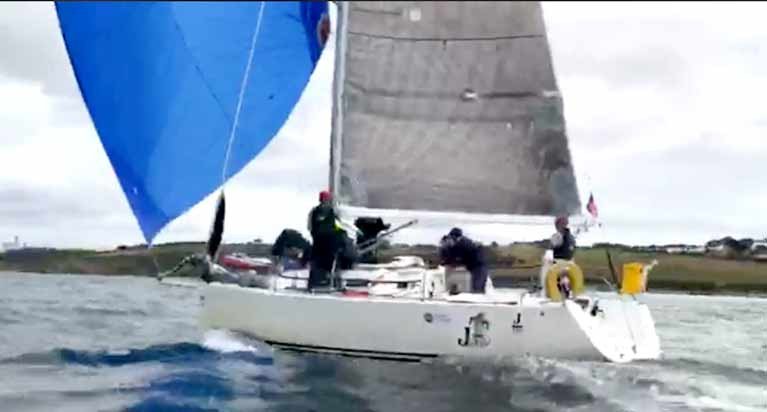 After a spot-on tactical call over the final few miles. Joker 2 sweeps across the lines to win the Fastnet Race in the Beaufort Cup series in Volvo Cork Week.
After a spot-on tactical call over the final few miles. Joker 2 sweeps across the lines to win the Fastnet Race in the Beaufort Cup series in Volvo Cork Week.
The rest of the week was a tough battle, particularly the last race when we were over the start line and had to go back and re-cross the line in a double points race. But yet again, in adversity true teamwork came into its own. Huge performances were put in by the whole team, notably Ensign Marcus Ryan and Louis Malloy sailing a flawless race to get us back into the fifth position we needed to secure overall victory in the event.”
A €10,000 prize goes to the winning Beaufort Cup team, and we gave €5,000 of this to Crumlin Children’s Hospital in Dublin, while the other €5,000 went to the RNLI, something special for us as the Baltimore RNLI crew skippered by Youen Jacob had run us a very close second in the overall series in Cork.
In summary, military tools for campaign planning combined with values of teamwork and resilience stood to the Defence Forces sailing team throughout last year’s ambitious campaign”.
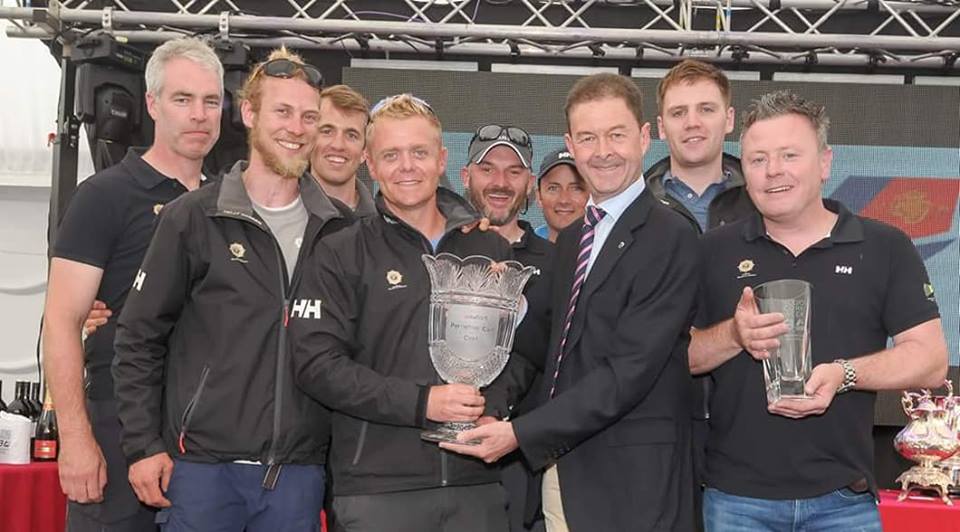 Mission accomplished. Joker II’s team with the Beaufort Cup include (left to right) Cpl. Brian Phelan (Rtd), Louis Malloy, Ens. Marcus Ryan, Commandant Barry Byrne, Malcolm Moir, Capt. Ian Travers (Rtd), David Thomas of Volvo Car Ireland, Lt. Richie O’Hagan, and Sgt Patrick McGrath
Mission accomplished. Joker II’s team with the Beaufort Cup include (left to right) Cpl. Brian Phelan (Rtd), Louis Malloy, Ens. Marcus Ryan, Commandant Barry Byrne, Malcolm Moir, Capt. Ian Travers (Rtd), David Thomas of Volvo Car Ireland, Lt. Richie O’Hagan, and Sgt Patrick McGrath
Wicklow Sailing Set for Round Ireland Man Overboard Lecture on Saturday
Anticipation is building ahead of Saturday’s talk in Wicklow Sailing Club about the Lesson learnt on board Jedi in the Round Ireland Yacht Race.
As Afloat.ie reported previously, the INSS Jedi team have been meeting frequently to ensure no detail of the story is left untold!
Wicklow Sailing Club has been busy too and have organised a flare demonstration to start at 1830hrs. For those that have been nervous about using flares up until now, this is your chance to get up close and personal with the different flares and learn how to operate them.
Food and refreshments will be served from 1830hrs with the talk commencing soon after.
If you cannot make the talk this weekend, then there is a further talk at the Royal Irish Yacht Club 1930hrs on 7th of February with Sailing Supper Afterwards, bookings with [email protected]




























